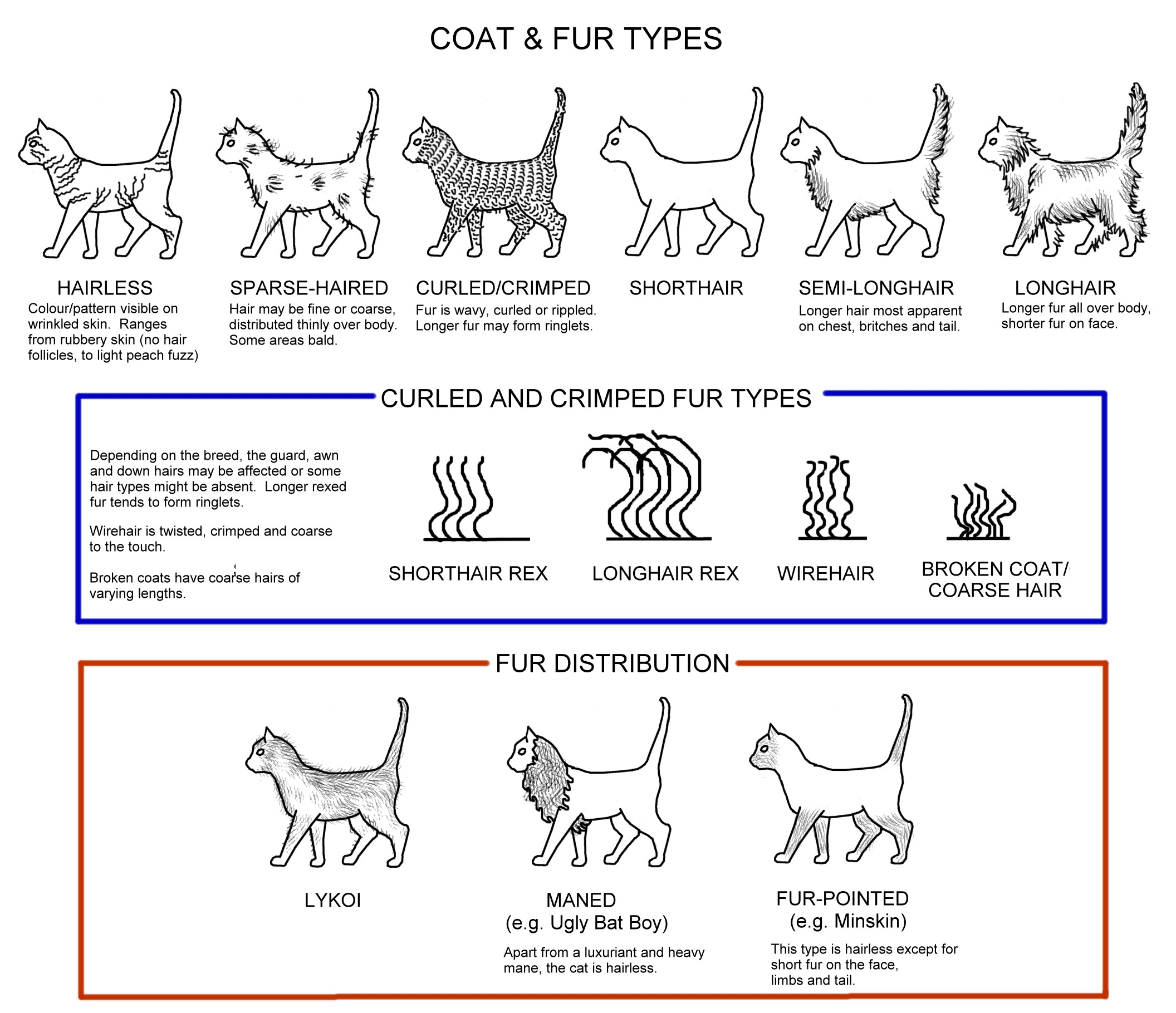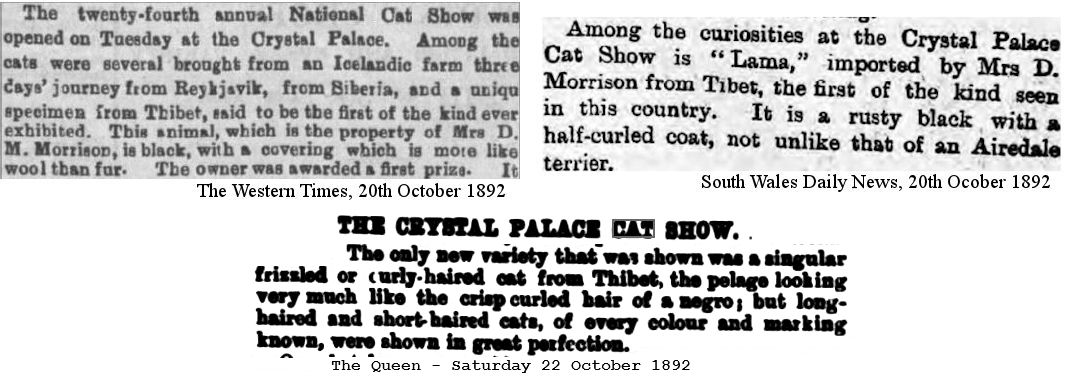
CURLY-COATED CATS
The origins of the major Rex breeds are well documented elsewhere so I have included a summary only. In some instances there appear to be several versions of events, dates of origin or disagreement over some issues. I have arranged the Rex discoveries, as far as possible, in chronological order. Where this is the case, I have included all relevant information without prejudice. Other opinions are mine alone. I have also managed to trace back to the earliest account of a curly-coated cat which was in 1892!
REX CATS
Curly coated cats have appeared Europe and America from time to time. Some have been bred, some were considered curiosities and have been lost. Several have proved to have the same type of mutation, others look similar but are genetically different. Curly coated cats are known as Rexes after the Rex type of rabbit. This term has therefore been applied retrospectively to early curly-haired cats which died out within a single generation as a recessive gene became hidden again.
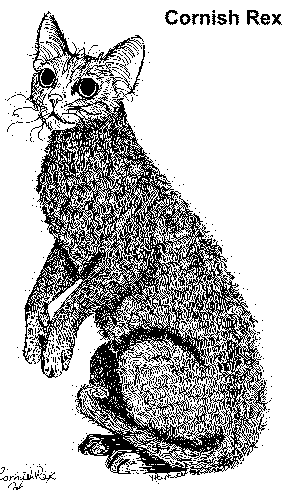
"Since nature does not recognize a curly-coated cat, short-haired or long-haired, the production of such varieties will in due course, inevitably give rise to trouble in one form or another. The breeder ignores Nature s rules at his own peril." May Eustace, The World of Show Cats (1970)
1876. MR WEIGHTMAN'S "POODLE-COATED" CAT
THE POULTRY AND DOG SHOW Hampshire Telegraph, 24th June 1876 ("The Poultry and Dog Show") refers to a possibly curly-coated cat exhibted at a show run by the Portsmouth Ornithological and Zoological Society: "The long shaggy coat of one of Mr. Weightman's cats resembled the hair of a Poodle dog."
1892. THIBETAN
The "Thibet" cat imported by Mrs Mclaren Morrison appears to be the earliest account of a rex-coated (curly coated) cat. "A unique specimen from Thibet, said to be the first of the kind ever exhibited. This animal, which is the property of Mrs. D. M. Morrison, is black, with a covering which is more like wool than fur." (London Evening Standard, 19th October 1892). Among the curiosities at the Crystal Palace Cat Show is "Lama," imported by Mrs D Morrison from Tibet, the first of the kind seen in this country. It is a rusty black with half-curled coat, not unlike that of an Airedale terrier." (South Wales Daily New, 20th October 1892). "The Thibetan cat, never before exhibited is a curious black animal with a woolly coat, as different from the long silky hair of the English cat as a negro s crop is from a modern belle s." (Exeter and Plymouth Gazette, 20th October 1892). "The cat from Thibet takes a first prize, due, perhaps, to its rarity, for such a specimen has never been previously exhibited. It is black, and its coat is more like wool than a cat's fur." (Nottinghamshire Guardian, 22nd October 1892). "A very curious beast, says the correspondent of a contemporary, came from Thibet. There is a distinct species of cat in that country which is not domesticated, but this Thibet cat was simply extraordinary variation of felis domestica. It was long-necked and lean creature, with a grey black coat, the peculiarity of which was that it was just the texture of Irish frieze. " (Preston Herald, 22nd October 1892). "The only distinctly new variety in the exhibition was a cat stated to have been imported from Tibet. This was a small, dark, slate-coloured specimen with frizzy or curly hair very much like the short hair of a negro." (Illustrated London News, 22nd October 1892). Mrs Mclaren Morrison libed at Kepwick Park, Northallerton and imported and collected unusual cats. "Lama" (misquoted as "Lena" in some Crystal Palace reports) doesn't seem to have any recorded descendants. Possibly he never bred, or more likely his offspring were straight-coated. At that time cat breeders didn't understand recessive traits or that back-crossing offspring to the parent could recover those recessive traits.

1930s. PRUSSIAN REX
A curly coated cat now known as the Prussian Rex was discovered in Konigsburg (Kaliningrad), East Prussia in the early 1930s. Called "Munk" (or "Kater Munk") his name has been linked to the first German Rex cats which appeared in 1946. Munk was owned by Frau Schneider and was the offspring of a Russian Blue/ Chocolate Angora ("tobacco colour")cross. There were either one or two other curly cat in the litter, but they were castrated. Munk allegedly mated freely with local cats until his death in 1944/5, but he left no known descendents and there was no attempt to breed him in a controlled way.
1930s. KARAKUL
Another Rex-type, known as the Karakul Cat, appeared in the USA also in the 1930s. Though a novelty, the trait was never established as a breed in either case.
1940s. URAL REX
Perhaps the oldest established Rex variety (as opposed to breed) is a curly coated Russian variety which has been found in the middle Urals region since the Second World War, but which was not recognised as a breed until 1991. The Urals Rex has a wavy coat of short or medium length, body is strong and muscular. The gene causing the Urals Rex has been shown to be dissimilar to the Cornish Rex; its relationship with the gene for Devon Rex is unknown. The Urals Rex may have a tufted tail tip. The semi-longhair version has a looser coat, but is less popular.
The Urals Rex finally achieved recognition in 1991. Previously it had been a long-established informally recognised variety, but only when Russia developed a cat fancy following glasnost and perestroika, could cat breeds be properly developed, recognised and shown competitively. Under the strict communist regime, cat breeding was seen as a capitalist affectation. With its long history, it is considered to be the first homegrown Russian breed. Urals Rexes occurred as spontaneous mutations in feral cat populations in and around Yekaterinburg. Both occurrences were developed separately as breeds and not interbred, but they may prove to be genetically identical. Both breeding populations are reported to be highly inbred. The gene involved is known to be different to the German/Cornish Rex gene.
1950. ITALIAN REX
The Italian Rex discovered in Italy in 1950 also vanished after three Rexed kittens were born to a non-Rex mother (probably recessive gene).
1944 or 1953. OHIO REX
The Ohio Rex occurred in the USA in 1953 (other sources indicate 1944) but was lost. It appears to have first emerged in 1944, but was ignored because of World War II. The gene was not lost and in 1953 a curly coated male kitten was born to a domestic cat owned by Mary Medderman of Plainsville, Ohio. Called Toni, this cat died aged 10 months from an infection, but 3 more curly coated kittens were born to the same parents. No serious programme was established and the mutation died out - somewhat unfortunately after it had survived for almost 10 years since its first discovery. Regrettably Miss Hedderman was unable to continue with breeding cats, but she provided British geneticist A C Jude with colour slides of the cats. Hair samples were not available as the whole of Miss Medderman's cat family had been put to sleep.In the CFA Yearbook 1965, Helen Weiss wrote "The first recorded Rex mutation in America was in 1953, when Miss Mary Hedderman then of Plainsville, Ohio, had a normal coated domestic cat who had the curly kitten, Toni, pictured here. (This picture illustrates the great difference in conformation between Rex kittens and their normal coated litter mates. Notice the large ears, the long narrow head and slender legs of Rex.) Unfortunately Toni died of enteritis at ten months. Subsequent litters from the same mother produced three more curly kittens but by that time we had acquired a total of nine cats and couldnt keep them. The only characteristics that differed in any Toni and his normal coated brother way from the other kittens was his playing. He never seemed to rest or sleep, constantly trying to rouse some of the others to romp with him. (From a letter written by Miss Hedderman to Mrs. Ennismore in October, 1956) . No more is known of the Ohio strain unless a cat, reported to live near Columbus, Ohio, described to a neighbor of ours in Sugar Land who was visiting in Ohio, as "a different kind of cat with curls all over him" might be one of the kittens referred to in the letter. The author tried to contact the owners of this cat for information but was unable to do so."
1950. CORNISH REX
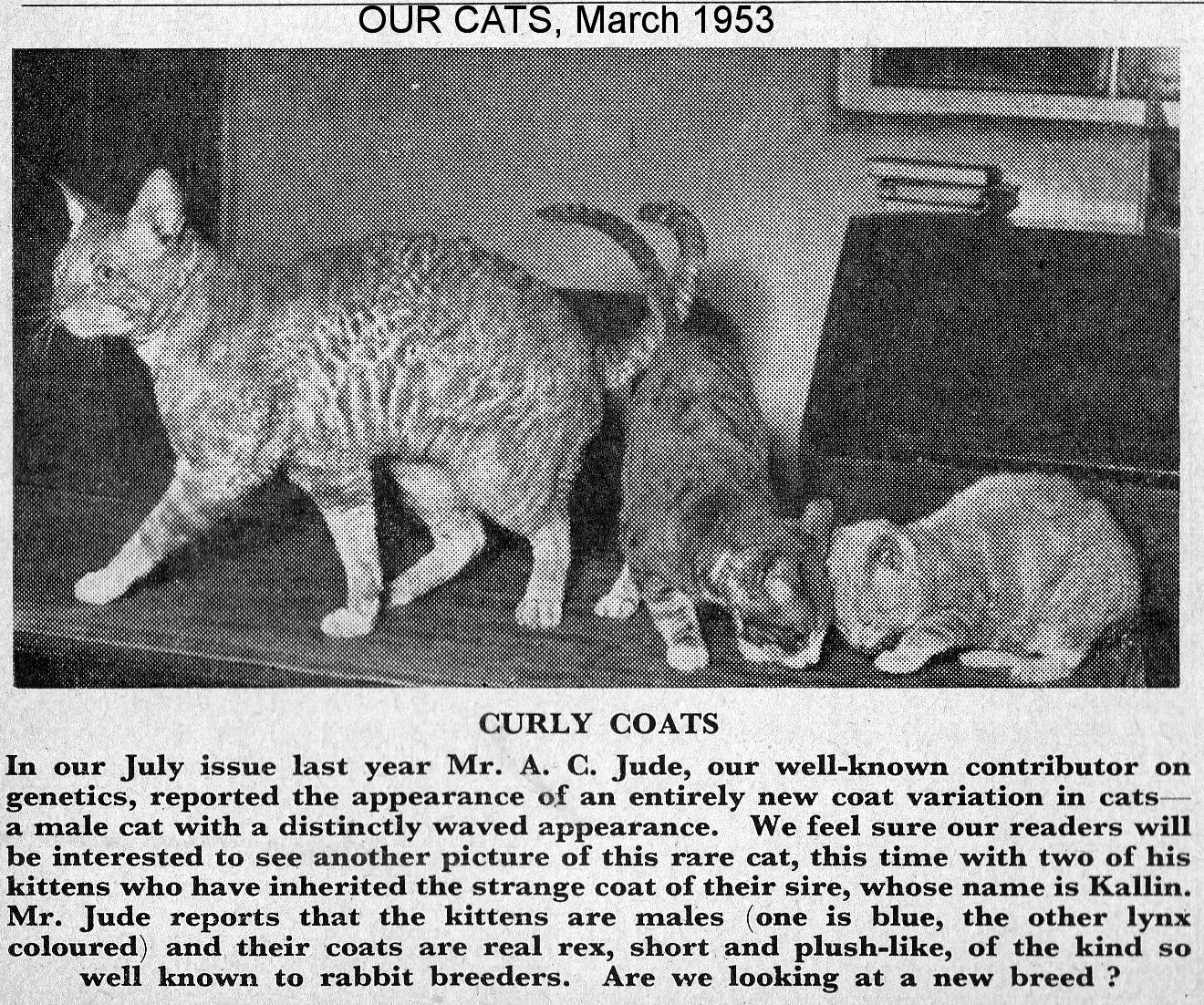
So although curly coated cats have appeared from time to time, the first formally recognised Rex breed was developed from a curly-coated cat discovered in 1950 in Bodmin, Cornwall, England. Kallibunker became the founding father of the Cornish Rex breed. Cornish Rexes are lean with whip-like tails and a long, large-eared face. The fur falls into close-lying ripples as though the whole body surface has been crimped. There appear to be no guard hairs, although more recent studies have suggested that guard hairs are present, but in very modified form. The Longhaired Cornish Rex exists but is not very popular; longhaired cats turn up from time to time as the gene for longhair is recessive. To avoid confusion, these are sometimes known as British Cornish Rexes or European Cornish Rexes since the American version has diverged greatly from the original Cornish Rex. It was originally known as the English Rex until the Devon Rex appeared a few years later.
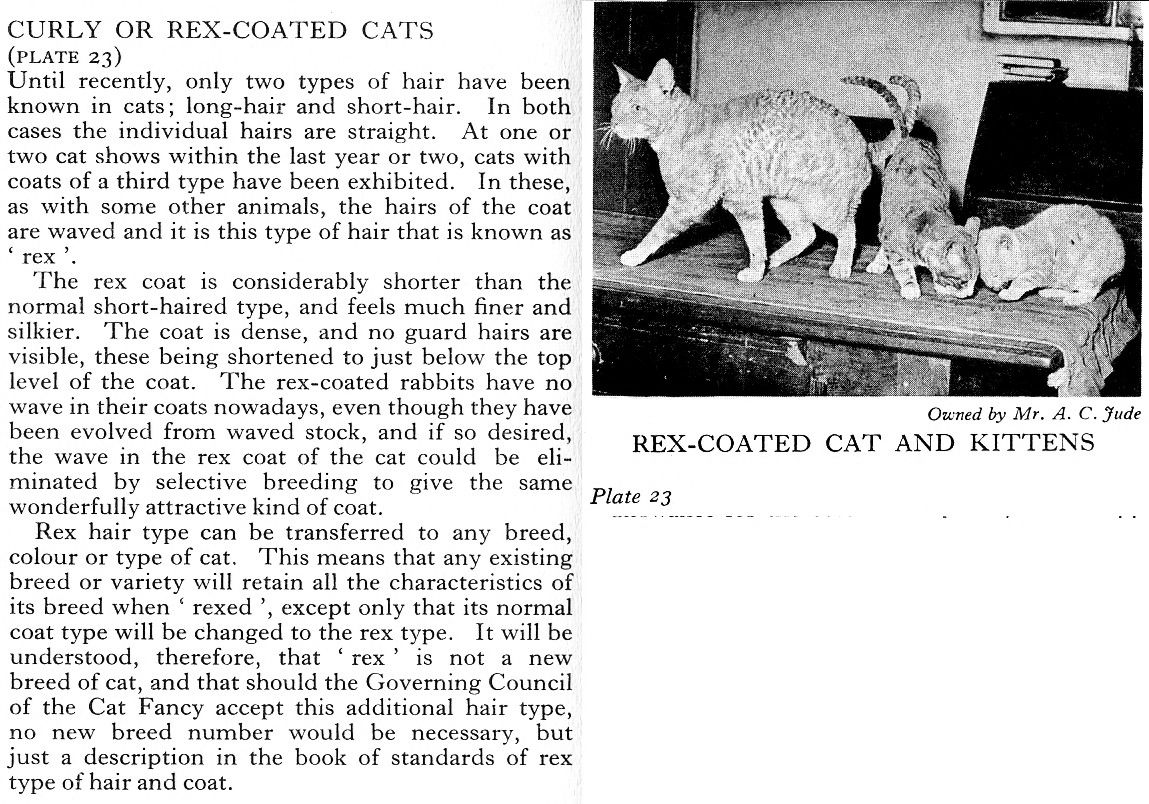
According to A.C. Jude, writing in Our Cats, December 1959, "The English Rex, for instance, was found to be carrying a lethal factor, whereas the German Rex mutant has consistently, in and through its progeny, produced only perfectly healthy stock." He mentioned that similar cats had been found in Lincolnshire and Ireland, but gave no specifics on locations.
In The Observer Book of Cats (1959) Grace Pond wrote that curly fur could be introduced into any breed without any need to change the breed name. The GCCF would merely require an description to be added to the cat to denote it had rex fur. "At one or two cat shows within the last year or two, cats with coats of a third type have been exhibited. In these, as with some other animals, the hairs of the coat are waved and it is this type of hair that is known as rex . The rex coat is considerably shorter than the normal short-haired type, and feels much finer and silkier. The coat is dense, and no guard hairs are visible, these being shortened to just below the top level of the coat. The rex-coated rabbits have no wave in their coats nowadays, even though they have been evolved from waved stock, and if so desired, the wave in the rex coat of the cat could be eliminated by selective breeding to give the same wonderfully attractive kind of coat. Rex hair type can be transferred to any breed, colour or type of cat. This means that any existing breed or variety will retain all the characteristics of its breed when rexed , except only that its normal coat type will be changed to the rex type. It will be understood, therefore, that rex is not a new breed of cat, and that should the Governing Council of the Cat Fancy accept this additional hair type, no new breed number would be necessary, but just a description in the book of standards of rex type of hair and coat."This was before the appearance of another type of rex cat in Britain; with 2 different types of rex fur, the GCCF abandoned this early proposal.
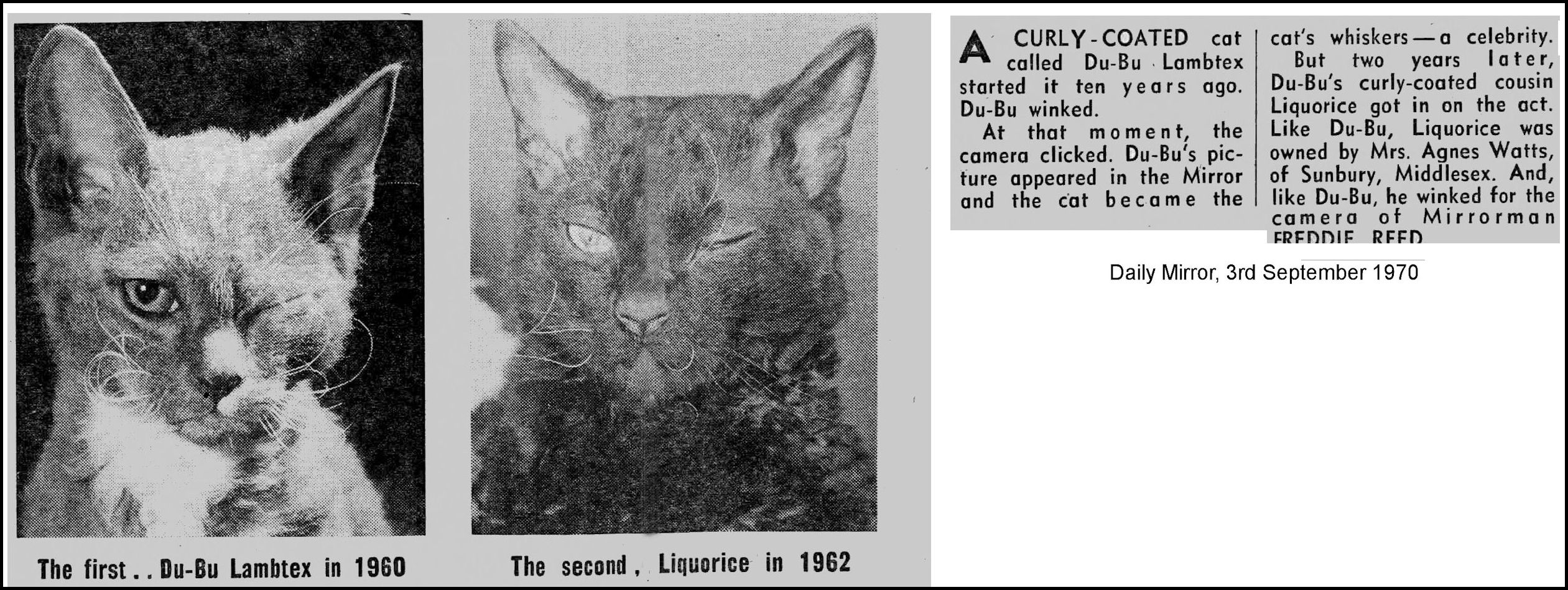
Du-Bu was the prefix of Agnes Watts (mother of Susan Luxford-Watts, Amaska prefix). She was an instrumental early breeder of Cornish Rex. Du-Bu Lambtex was due to appear at the Kensington cat show after the original article in July 1960, but was absent because he apparently had toothache. He is believed to have died in 1960. The Du-Bu prefix appears in some Devon Rex pedigrees due to early test-matings of the Cornish and Devon cats (Devon Rex Kirlee lived with Agnes Watts for a while).
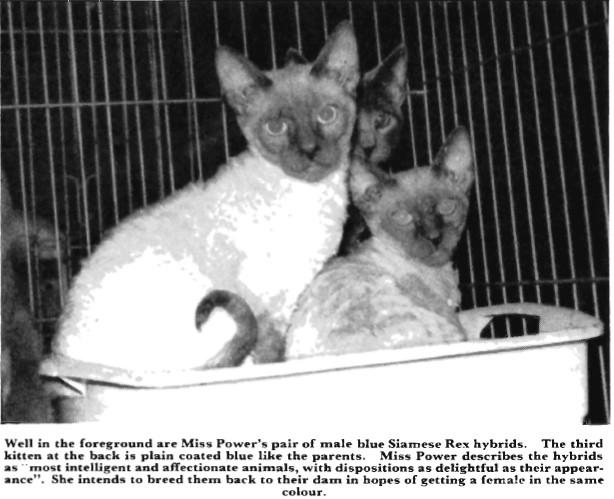
In others the prefix "Si" is used e.g. the Si-Rex is a colourpointed Rex and is further identified as Cornish Si-Rex or Devon Si-Rex. In the American "Cats Magazine" of June 1965 there was a photo of two Blue-Point rex-coated kittens born to a blue self (Cornish) Rex in August 1964. Their pedigree showed that four generations back, there had been a Blue Point Siamese outcross in the breeding program. In addition, one ancestor was an Oregon Rex mutation owned by Mrs Mildred Stringham of Warrenton, Oregon. A Si-Rex was being developed in England at the same time, by Mrs Ashford (Annelida prefix). The "Si-Rex" breed (colourpointed Cornish Rexes) achieved recognition in the USA in 1986.
In America, there was a single breed called "Rex" until the late 1970s when it was evident that Rex types I and II (Cornish and Devon) could not be judged to a single standard. The American-bred Cornish Rex has been developed to be quite different to the ancestral British Cornish Rex. The American Cornish Rex has a different look and different genetic history and should, perhaps, be considered a separate breed. It started as a hybrid between Cornish and German Rexes but this lost the Cornish Rex body type so it was crossed with Orientals resulting in a more delicate and long-legged version than the British Cornish Rex. This also produced the Si-Rex which is recognised as a separate breed in America. In the UK, colourpoint Rexes are simply a colour pattern.
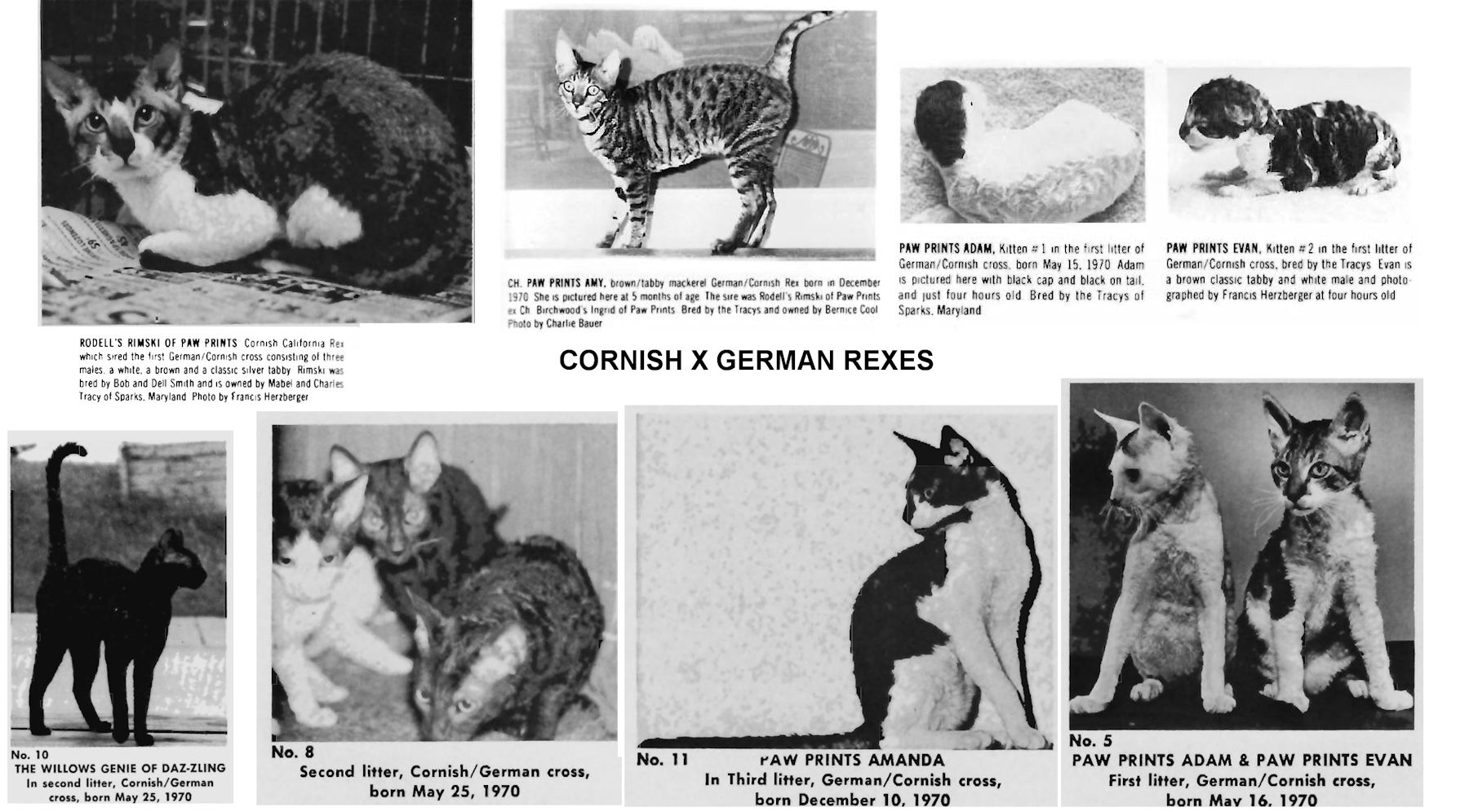
1950s. GERMAN REX
According to some sources, the German Rex may initially have occurred in 1946, but no interest was taken until the 1950s.
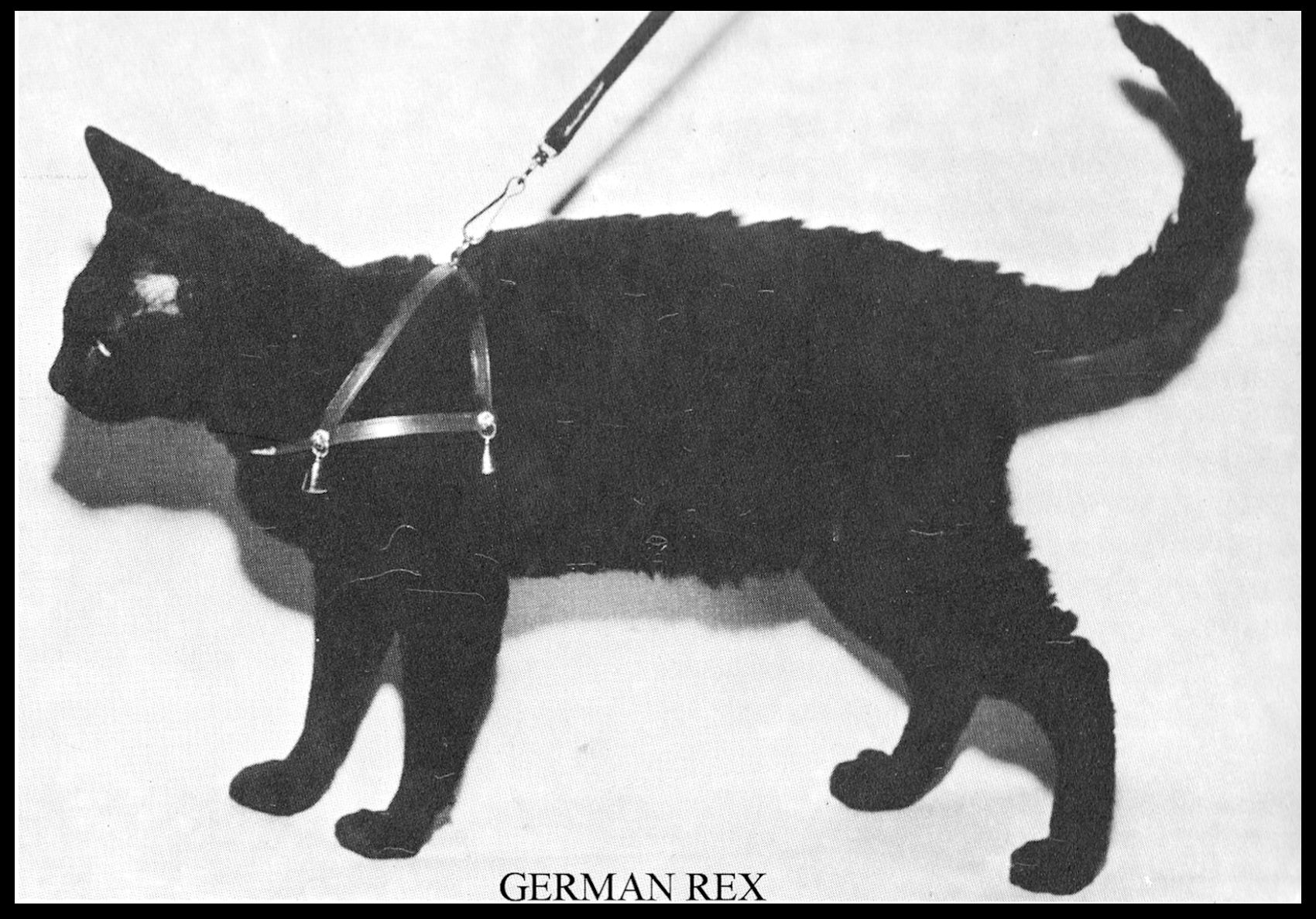 The German Rex was discovered a year after the Cornish Rex in 1951 at Berlin's Hufeland Hospital by Frau Dr Scheuer-Karpin. A curly-coated stray cat known as Laemmchen (Lambkin) had reared kittens in the hospital grounds. Some reports give 1946 as the date, which pre-dates the Cornish Rex and som suggest Laemmchen was a descendant of Kater Munk. If so, Laemmchen was then just a curiosity and there was no attempt to deliberately breed curly-coated cats until the 1950s, probably prompted by the discovery of the Cornish Rex. In any event, Laemmchen mated with one of her own sons in 1956, producing more Rex-coated cats. Test matings demonstrated that the German Rex was caused by the same recessive gene which caused the Cornish Rex. It is similar to the Cornish Rex but with a thicker coat and different body shape from mating with European Shorthairs. The Angora German Rex (Longhaired German Rex) is an important part of the German Rex breeding programme.
The German Rex was discovered a year after the Cornish Rex in 1951 at Berlin's Hufeland Hospital by Frau Dr Scheuer-Karpin. A curly-coated stray cat known as Laemmchen (Lambkin) had reared kittens in the hospital grounds. Some reports give 1946 as the date, which pre-dates the Cornish Rex and som suggest Laemmchen was a descendant of Kater Munk. If so, Laemmchen was then just a curiosity and there was no attempt to deliberately breed curly-coated cats until the 1950s, probably prompted by the discovery of the Cornish Rex. In any event, Laemmchen mated with one of her own sons in 1956, producing more Rex-coated cats. Test matings demonstrated that the German Rex was caused by the same recessive gene which caused the Cornish Rex. It is similar to the Cornish Rex but with a thicker coat and different body shape from mating with European Shorthairs. The Angora German Rex (Longhaired German Rex) is an important part of the German Rex breeding programme.
Laemmchen's kittens prior to Dr Scheuer-Karpin adopting her are unaccounted for and many of her later ones are untraceable. Laemmchen's last kittens were born in 1962 and she died in 1964. By 1968 only three of her direct descendents known. The Barensfeld family in East Berlin had maintained the pure German Rex lines and produced Ferdi, Roland and Silke von Grund. Various East German cat breeders had bred cats from Laemmchen's curly-coated offspring. In 1957, a German Rex kitten was sent to a British breeder but died soon after arrival. In 1960, some were sent to Paris but died in transit; a later export arrived healthy and was exhibited. In 1961, German Rexes were exported to the USA and enthusiastically bred. The breed was featured in an American magazine in 1971, though the last American-bred German Rexes were born in 1970 and the breed soon vanished and was forgotten. It seemingly could not compete against the Cornish and Devon Rexes.
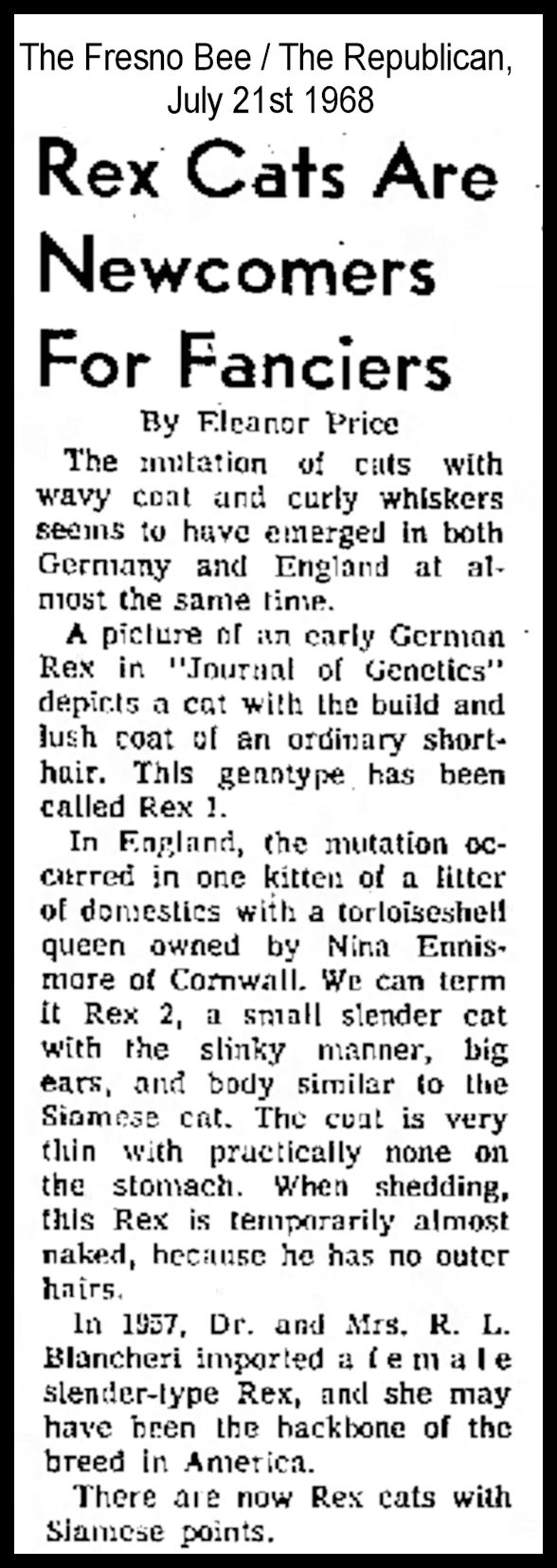
Swiss breeder Fru Schwarzenbach revived the German Rex. By 1999 it was down to only 2 known breeding females (Batu Happy von Quiomme and Bonsai the Frizzled Frolic) and no breeding males. Since there might be unneutered pet German Rexes, she advertised for a male. A cat rescue centre responded in 2000 that they'd obtained a male and female from a former breeder who was giving away his remaining cats. Unfortunately, during collection, the male panicked, was injured and had to be put down. The pregnant female miscarried and had to be spayed. The breeder's remaining cats were either feral or were sick and died. To make matters worse, 3 year old Batu Happy von Quiomme developed a womb inflammation due to not being bred so it was imperative she be mated otherwise she would have to be spayed. The closest in conformation to the original German Rex was the Abyssinian so an Abyssinian stud was used and his German Rex/Abyssinian male offspring were mated to pure German Rex female Bonsai and a rescue female that was now of age. Then in 2005, some "German Rexes" turned up in Stralsund, NE Germany when a cat breeder requested help homing two litters of German Rex. They turned out to be descendents of known German Rex lines and useful additions to the gene pool. Their sire's ancestors included a black rex kitten (Pumina) found in 1993 on a building site only 14km from where Lammchen had been found. Pumina's own kittens were straight-coated, but when bred among themselves the rex coat re-emerged. She was possibly one of the "lost" descendents of Lammchen.
Further "German Rexes" occurred in Berlin, Essen and Siegburg. These are far enough apart that they were probably different mutations to Kater Munk and Laemmchen. A Rex-coated black and white male cat turned up as a spontaneous mutation in Sieburg (close to Essen) in 1979. Named Pushkin (renamed Kater Preu) he was used in the German Rex breeding programme but turned out to have a different mutation to the German Rexes he was bred to. As a result, Kater Preu was neutered. When mated to a German Rex, Preu produced straight-haired offspring. Some of those offspring were bred together and produced rex kittens (a recessive gene) that were termed German Rex. Sadly, no-one thought to investigate his mutation further and the Sieburg Rex was lost.
1959. CALIFORNIA REX / MARCEL CAT
The California Rex (better known as the Marcel Cat) was first discovered in California in 1959 cats in a rescue centre in San Bernadino. They had been handed over by their owner because they were peculiar looking. Fortunately Bob Smith found the mother cat and her male kitten: a female odd-eyed tortie and her red tabby son. Their wavy-haired coats were more unusual than the Cornish Rex in that they were fine and silky and longer than that of other rex cats Because of the length Mr Smith elected to call the coat "marcel" rather than rex. The calico was named Mystery Lady of Rodell and her son was called Terry. Mr Smith devised a series of crosses, utilizing the marcel coat with the Cornish Rex. The first such cross was between Mystery Lady and Fan T Cee Blue Boy, a normal coated carrier of the Cornish rex gene. Three normal coated kittens were born, August 13, 1960. The marcel was considered to be compatible with the Cornish Rex and was incorporated into the Cornish Rex lines in the Smith's cattery. As the CFA report stated "Had it been desirable, or if the discoverers of the wavy, semi ionghair coat had wished, the California coat could have been established in much the same way as the Cornish Rex had been. But breeders intimately involved must make such decisions. It is difficult to travel in two directions at one time and assume a responsibility that requires time, money and space in a cattery."
In the CFA Yearbook 1965, Helen Weiss wrote: "California (Long Haired Without Guardhairs)." As Rex cats are short hairs, this will only be included as a matter of interest. In 1960 a curly longhaired calico cat and her long haired red son, both completely lacking guard hairs, were reported to Mrs. Blancheri. Although she was not raising cats at the time, she obtained this pair and working with Bob and Dell Smith they carried on this new strain to find out how they were related to the English Rex. Because they were not shorthaired as Rex cats are, they were called Marcels. The calico queen was bred to Peggy Galvin's [Cornish Rex/Blue Point Siamese] hybrid, Blue Boy, the resulting litter, a male and a female, both had normal shorthair coats. This brother and sister were bred together and the result was three blue cream and white shorthaired Rex kittens. It is not known if these kittens were bred back to cats of either side of their pedigree, but it would be interesting to know if they carried the Rex or lack of guard hairs from both sides and would therefore have 100% Rex litters bred to either side. The Smiths did not carry on with the Marcels, because of the longhaired background, and no other information is known about them. The long hair hid the type on these cats and the lack of guard hair made the coat limp and rather lacking in texture. The hair was curly and with greater length tended to spiral and separate rather than to give the appearance of waves as in the shorthairs."
1959. OREGON REX
The Oregon Rex found in the USA in 1959 is another vanished mutation. Like the Ohio Rex, the Oregon first emerged in 1944 and was ignored due to the war. In 1959, Mrs Mildred Stringham of Werrenton, Oregon found a wavy coated black-and-white female kitten in a litter born to her tortoiseshell cat, Callie, on May 9, 1959. She called the kitten Kinky Marcella. It proved to be a recessive gene, but cross-breeding with both Cornish and Devon Rexes produced non-Rex kittens. Kinky was one in a litter of four, the three litter mates had normal coats. Upon reaching maturity Kinky Marcella was crossed to Cornish Rex stock and produced only normal coated kittens. Through several back crosses Mrs Stringham finally acquired sufficient breeding stock to establish a line Kinky Marcella died May 23. 1972 Since she had been born in Oregon. Kinky was called the Oregon Rex. Geneticist Roy Robinson stated that the Oregon coat samples were very similar to both the Cornish and German coats. At that time, breeders in the USA classified the rexes as a single breed (articles in CFA yearbooks state this approach) and new rex mutations were generally incorporated into the existing Rex breed (which was already a mish-mash of Cornish, Devon and German rexes).
In the CFA Yearbook 1965, Helen Weiss wrote "In May, 1959 Mrs. Selby (Mildred) Stringham of Warrenton, Oregon, found a little black and white female with extremely short wavy fur, in a litter of otherwise normal kittens, born to her calico domestic cat. This kitten, named Kinky Marcella, was the original mutant of a new strain. Mrs. Stringham wrote to Mr. Jude, sending pictures and a description of her cat, who identifies her as "Rex" and advised that she be bred to a Rex male. Since Marmaduke was the only fertile Rex male in the country and he was in Texas, Kinky was bred to Mrs. Galvin's blue hybrid Rex [Cornish Rex/Blue Point Siamese], the result was five normal coated (blues and blacks) kittens, all males! Probably the Rex genes of the two strains were not compatable butthis of course could not be proven until such time as the Rex coated individuals could be bred together. Bred to one of the kittens from this litter, Kinky had a litter of four, two of which were Rex. We were entranced with these lovely kittens. Subsequent breedings have produced some very beautiful cats. Her work and the results of this work is fully described in February, 1964, issue of All Pets."
KINKY MARCELLA by Mildred G. Stringham (Cat Fancy, August 1970)
Because the original Rex cats emerged as natural mutations, in different parts of the world, the breed stands out as particularly unique from all others. The arrival of just such a kitten caused much excitement in our home on the morning of May 9, 1959. How strange she looked lying beside her three normal-coated littermates and their dam, Callie, one of our shorthaired household pets. This tiny black and white creature's short fur, which barely covered her body, lay in fine narrow marcel waves and she felt amazingly like satin. Except for a quirk of fate, this kitten might never have been born. We had originally given Callie to a couple who planned to have her spayed before she matured. But Callie and the family dog refused to adjust to each other. When we brought Callie home, she was so happy we vowed to keep her. Later, when this karacul kitten arrived, we laughingly said, "Callie must have really been scared by that dog!" And, oddly enough, as the kitten grew, her appearance and traits seemed destined to hover between canine and feline. Her peculiarities continually amazed and amused us. Her large ears, the odd body structure, plus the short, soft, wavy fur, set her apart from our other cats; instead of meowing, she seemed to "talk" deep down in her throat; dragged Turkish towels and rugs around to make a bed of them; and retrieved everything. We decided to nickname her "Puppy Kitty."
When our fascinating little oddity was about six months old, we learned of the late British geneticist, Dr. A.C. Jude, who helped supervise the breeding of Kallibunker (the first recognized Rex). Photos and a description of our kitten were sent to Dr. Jude who definitely identified her as "Rex" and advised us of English Rex [i.e. Cornish Rex] in Southern California. He suggested we mate our mutant to one of these Rex, or use our kitten's sire. We believe that our kitten's sire and great grandsire was the same cat: a black and white neighborhood stray, who had a flat wavy tail, and curly fur on the underside of his body. Our attempts to locate and confine him were unsuccessful.
We decided to breed Kinky to a normal-coated blue son of Diamond Lil [Diamond Lil of Fan-T-Cee, Cornish Rex], who was a proven sire of curlies, and while the possible incompatibility of genes had been considered, Kinky's normal-coated litter was a great disappointment. We kept one black and one blue, and in backcrossing the blue to his dam [Kinky], we produced two Rex and two normals. Before our blue hybrid matured, we bred Kinky to an orange, normal-coated tom in an effort to establish a strictly American line of Rex. Also, since the sire was a distant relation, there was the possibility of Rex kittens from this breeding. But again they were all normals. Luckily, two of the litter were females and these were bred to their half-brothers from Kinky's first litter, then back-crossed. Sterility is often a problem among Rex cats, and we were never able to breed a "strictly American" Rex-coated cat, as hoped. Various matings resulted in false pregnancies; we lost both American female hybrids before further outcrossing to other domestics could be pursued, and when Kinky developed a dangerous uterine infection, we had her spayed.
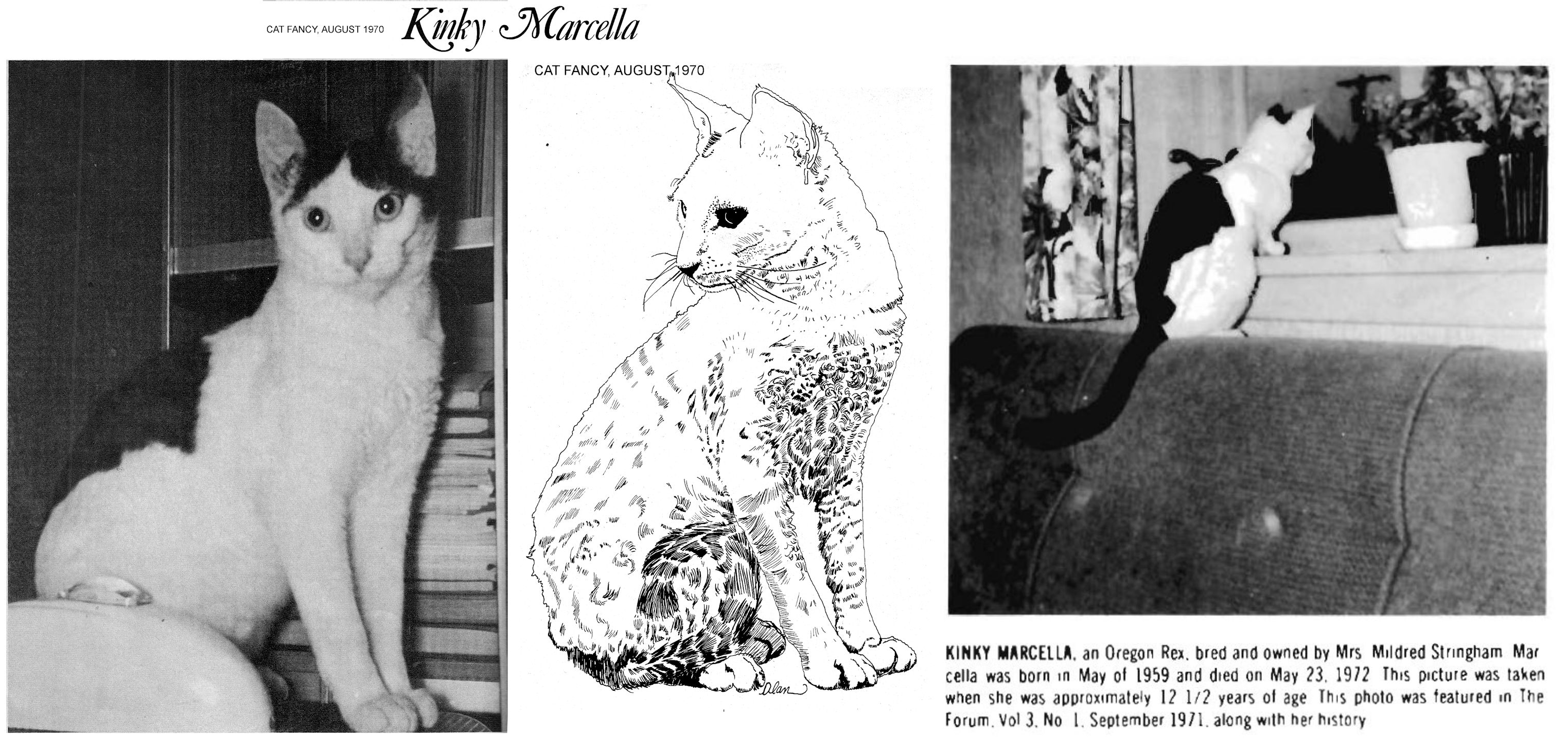
When breeding Rex-coated cats to normals, all hybrid offspring will be carrying the Rex factor, but when these are bred back to sire or dam, the normals in these litters may, or may not, be heterozygous for Rex. This can be determined only by keeping them all to maturity, and following a process of elimination - a very costly procedure. It is most interesting to watch the incredulous look on a person's face when you point out a pair of very domestic-looking cats as the parents of an extremely curly Rex. Yet, genetically speaking, these Rex-coated offspring are as pure Rex as those with generations of pure Rex behind them, and when bred to homozygotes of the same strain will give all Rex litters. As was the experience of the early breeders of Rex rabbits, it has been found that the genes of the two English strains of Rex were incompatible. My original breeding of Kinky to the English [Cornish] hybrid showed her strain also to be a separate recessive. To my knowledge, no one has yet attempted to interbreed the German Rex with any other line.
During the last few years Miss Mary Carroll of Hamilton, Ontario did some experimenting with several of my Rex and both her English Gene I and II Rex, with good results. Miss Carroll is the only breeder I know of who has done any breeding with both English and American genes, but, undoubtedly, all lines will eventually be combined. This will not only strengthen the stamina of the Rex by using more distant outcrosses, but will also assure future breeders that their cats will be pure Rex. Potential buyers can now be assured of this, of course, simply by buying a pair of Rex-coated cats which are progeny of the same original mutant. But these breeders will be deprived of some of the excitement of an experimental breeding project. Quite often the unpredictable results were both fascinating and frustrating. For instance, I once mated two normal-coated cats I believed carried the Rex gene, and produced all normals; on the other hand, one Rex-coated female bred to a normal-coated male produced all Rex! And nothing can quite compare with the thrill of seeing those newborn curly kits. My Rex were all born curly, but after a week or so the wave all but disappeared, to return again within a few months. However, one of my curliest males did not develop his lovely coat until he was nearly a year old.
Mrs. Ennismore, a breeder of Rex cats in England, writes of similar experiences: "All my Rex kittens were born curly from top to toe. They all went smooth later on, but when they reached a year old the curl came back in most of them and with each added year of life, they became curlier and curlier."
Although the curl in the Rex cat is perhaps, the breed's most outstanding asset, it is unfortunate so little emphasis has been placed on the unbelievably ultra soft-as-down fur. Breeders of Rex rabbits considered the wave unattractive, and since it was not popular on the fur market, was bred out of the animals. The description in today’s Rex rabbit standard reads much the same as that of the cat, but any appearance of curl or waviness is a fault. Dr. Jude, in his book, Cat Genetics says of Rex: "The main object is to eventually. produce from the wavy coat, a coat which will be similar to that displayed on the Rex rabbit of today - very short and plush-like without waves. When this is done, it is expected to have an improved short coat for cats, just as the Rex coat is an improvement on the normal type of rabbit coat."
Most breeders of Rex cats will take exception to Dr. Jude's statements, but since "Rex" is a type of fur - just as long or short hair – it is quite possible that in future years there will be cats shown of every breed with Rex fur - curly or smooth. It is hoped, however, that present and future Rex breeders will lean neither too far toward the domestic or foreign (Siamese) type of cat, but work to retain the individual body characteristics of Nature's original models, which were unique and attractive: Lithe, yet sturdy body, supported by long, slender legs with dainty feet; large ears, deep-set eyes, sleek Egyptian profile, regal head – all complementing the curly coat, whiskers and eyebrows. Into this fantastically different cat personality, Nature has blended many lovable feline traits familiar to us from other breeds, plus a few new and extraordinary ones. Then for outward glamour, she has added a luxurious coat of incredibly soft, wavy fur.
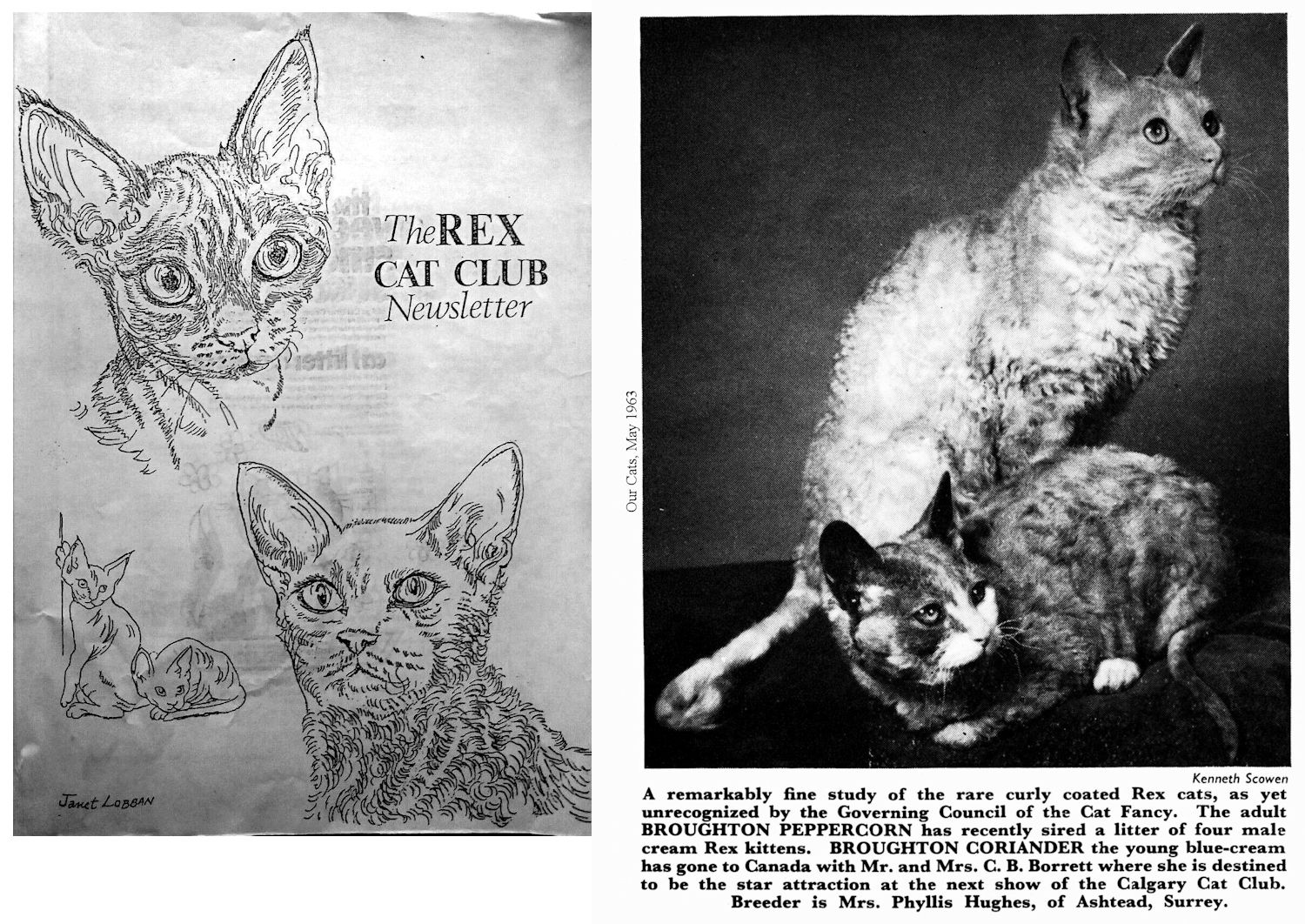
1960. DEVON REX
The second Rex breed to be formally recognised was the Devon Rex (formerly the Butterfly Rex) discovered in Buckfastleigh, Devon, England in 1960 and named Kirlee. This was a curly-coated grey male kitten in a litter born to a tortie female. Its discoverer had previously seen a cat with tight curls in and around a tin-mine in the area which suggests it was the kitten's father.
For some years a local variety known colloquially as the "Buckfast Blue" was reported in the area of Buckfast Abbey, Devon. This was a strain of free-ranging (mostly stray and feral) grey-blue cats with slightly woolly, wavy coats. These were apparently a familiar sight in the 1950s and considered nothing more than an attractive curiosity by locals. The Buckfast Blue may have been longer coated versions of the Devon Rex; the colour was probably coincidental though it is interesting that Kirlee was grey. The Buckfast Blue strain has since been lost through random breeding - the one reference I found was a reminiscence in an old Cats Protection League newsletter and lamented its disappearance.
Kirlee was initially assumed to be a Cornish Rex since the two are neighbouring counties, but when mated to a Cornish Rex, only straight-haired kittens resulted. This meant it was a different genetic mutation. The Devon Rex has very large, low-set ears and a short face giving it a gremlin-like appearance. The body is slender with a broad chest. The wavy coat is a looser and less rippled than the Cornish and the whiskers are twisted. The Longhaired Devon Rex, caused by a recessive gene, has a shaggy coat but is not currently pursued as a breed. Some consider its thicker coat to be more attractive than the sometimes sparse coat of the traditional shorthaired Devon Rex. More recently, the Devon Rex and the Sphynx genes have been found to be alleles (variants) of the same gene. Note for US readers: the proper name of the English county is "Devon" not "Devonshire".
Test mating between Devon and Cornish Rexes in the 1960s led to some crossing over of genes. A British breeder with both breeds also had an accidental mating between a Devon Rex and a Cornish Rex; such a mating would normally only produce straight haired kittens, but the litter contained two Rexes, something that could only happen if one of the parents carried the gene from the other breed. That gene would have been inherited from one of the test matings and passed down over many generations. These are sometimes called Double Rexes as they have both genes. Some of the progeny from test-matings were left in their respective genepools and occasionally a difference in the coats is noticed and may be due to the double Rex effect.
1962. IRISH REX
"When I first wrote about the Rex cats in 1962 I had quite a few letters from folk who claimed to have seen cats with curly coats. One came from a reader in Limerick who said she had seen a curly cat on her father s farm, but when I asked her to give more precise information she seemed unwilling to do so, so the idea of an Irish Rex was dropped from the picture." May Eustace, The World of Show Cats (1970)
1968. DUTCH REX
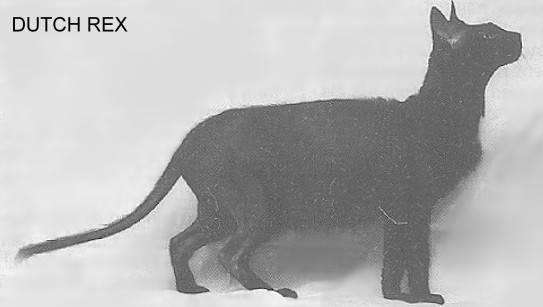
A Dutch Rex mutation appeared in Zaandam, the Netherlands in 1968. This mature female produced a rex daughter which bred with local normal-coated males producing further rex offspring. The rex daughter was then acquired by a cat breeder and her progeny were mated to unrelated straight-coated cats resulting in a mix of rexed and straight-coated cats. It was a dominant gene mutation and the hair tended to form dreadlocks. The coat ranged from wiry or springy to softer curls, but it was prone to balding in places and the unruly hair tended to become coarse as the cat matured. Some cats had bald backs and soft curly hair on the lower parts of the body. Others had bald hindquarters and longer, coarser, curly hairs one the forequarters. It was reported that the cats lost their curly fur if they bore offspring. The cats were bred for a short time, but the coats were always variable - one owner suggested it traced to an American Wirehair cat taken to the Netherlands by American military personnel. The slightly oriental conformation resulted from using Siamese outcrosses in the early 1970s. The Dutch Rex mutation was reported again in 1985, having a coarse wavy coat with a brittle texture and was also called the Wirehair Rex. Those reported in the 1980s were the offspring of the earlier Dutch Rexes. The last known Dutch Rex was an adult female found in the late 1990s on the streets of Amsterdam whose coat was closer to that of a rex cavy. She was never bred so no-one knows what gene she had. Apart from the 1990s female, whose origin was unknown, all of the Dutch Rexes could be traced back to the first mutant. The 1990s cat was initially believed to be a Blue Cornish Rex in poor condition, but was later recognised as a Black Dutch Rex. The dominant gene for Dutch rex produces a rex type of coat in the heterozygote and a very thin coat in the homozygote. All 3 hair types are thinner than normal and are crinkled.
1971. PENNSYLVANIA (OR MARYLAND) REX
In 1971, rex cats appeared spontaneously near Harrisburg, Pennsylvania. That summer, Mr Mark Ropel discovered that his cat had given birth to two curly coated kittens in a barn on Lakeview Farm in the vicinity of Harrisburg, Pennsylvania. The two male kittens, Elmo and Radar, grew to adulthood in hiss care. In April 1973 Mr Ropel s home was destroyed by fire, but the two rex cats escaped injury. Because of the tragic situation in which Mr Ropel found himself, he gave Radar to Mary Dunn of Towson, Maryland. Elmo was neutered and remained with his owner. The Pennsylvania Rex Cat had hair similar to the Cornish type. Breeding experiments to deter mine the type and to establish it were being conducted at the time of the CFA report in 1974.
Mary J. Dunn (Towson, Maryland) described another spontaneous Rex when she wrote to geneticist Don Shaw via Cats Magazine in December 1973: "Enclosed is a hair sample plucked from mid-spine of what may prove a new Rex. The cat in question - named Radar-was born in a litter of semi-feral barn cats. The parents and known grandparents of the cat are straight haired. As far as can be determined, there has been no contact between this barn population and registered Rex cats. A pedigree of sorts is enclosed. Radar was one of three kittens in a litter. Two males were curly and the only female was straight haired and died of exposure at about five weeks of age. Radar is eighteen months old now and displays lovely ASH type. He just recently came to my cattery after a tragedy at his own home caused him to need another desperately. As far as it is known Radar has sired no kittens.
Several Rex breeders in this area are working with me in setting up an experimental breeding program to determine presence and action of any Rex genes. I would very much appreciate your opinion of the hair sample. How does it compare with the known Rex hair types? Are we blessed with a new mutation? I find this possibility very exciting. If Radar does represent a new type I would also appreciate any suggestions you might have on the future breeding program. The female chosen for the initial experimental breeding is a white ASH of similar type and wholly unrelated. Radar himself is deep red tabby and white. My own cattery is quite small consisting of only a few Cornish Rex English imports. My Rex breeding experience is quite limited and I want to do what is right in this case."
Shaw replied "Upon examining the hair sample from your cat Radar: 1) There appears to be a lack of guard hairs; if not totally lacking, they are definitely reduced in appearance, resembling awn or awned-down hairs, 2) These are relatively longer than those generally found in either the Cornish or Devon. 3) The modified awn and/or awned-down hairs are not as uneven and grossly abnormal as is typical of Devon. 4) They appear to be evenly curved, with smoothly changing diameter, yet more developed than in Cornish or German coat. 5) Not having examined hair from Oregon Rex, but going only on the description in Roy Robinson's' book Genetics for Cat Breeders, Pergamon Press, 1971, there appears to be a striking similarity. There seems to be no doubt that Radar is rexoid. Due to the apparent awn hair development, he is possibly phenotypically most like the Oregon Rex. Your present breeding to a totally unrelated white ASH and proposed back-cross should establish the probable recessive mode of inheritance. This is already markedly suggested since Radar is the result of very close consanguineous breeding (mother/son) of two apparently normal-coated individuals. However, the definitive breedings are to Devon and to Cornish and/or German Rexes to confirm or deny whether the genetic locus is new. Please keep us informed about Radar's activities."
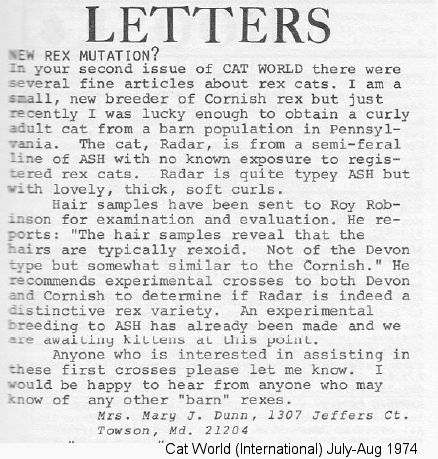
Unfortunately I was unable to find any more reports of the "Maryland mutation."
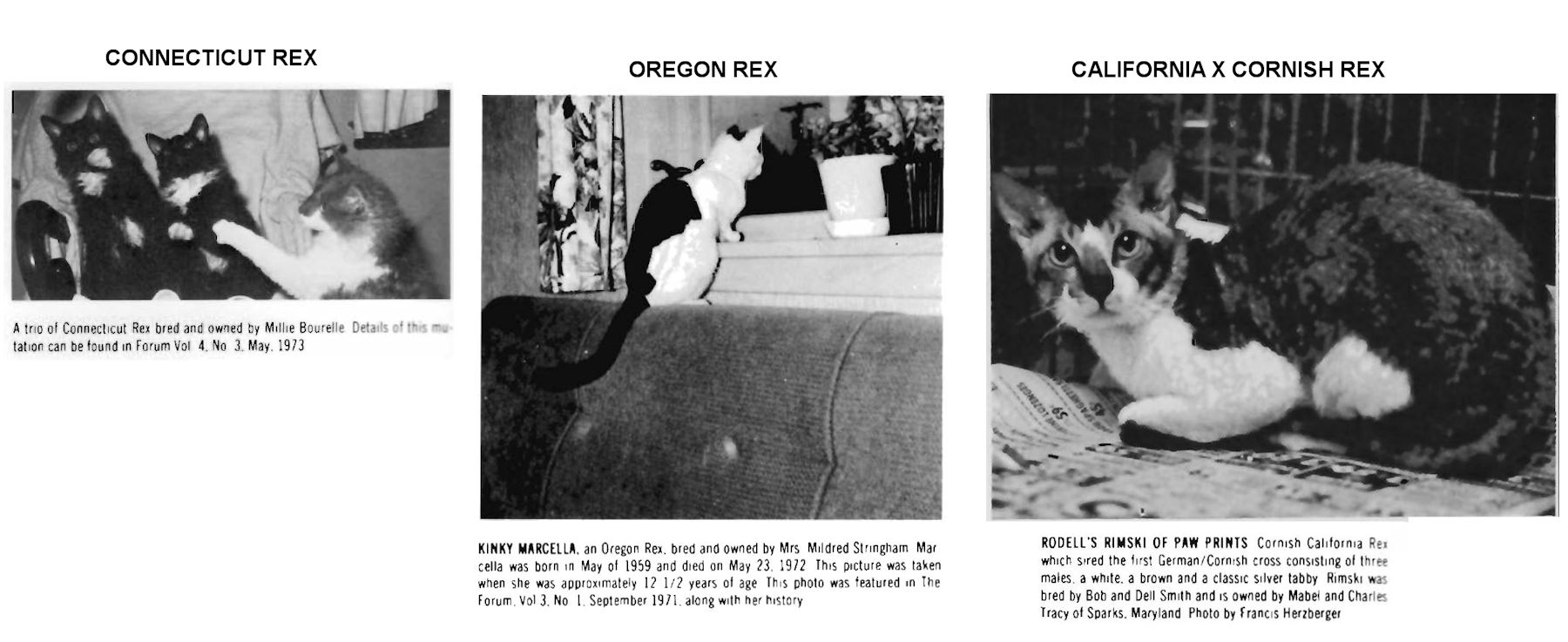
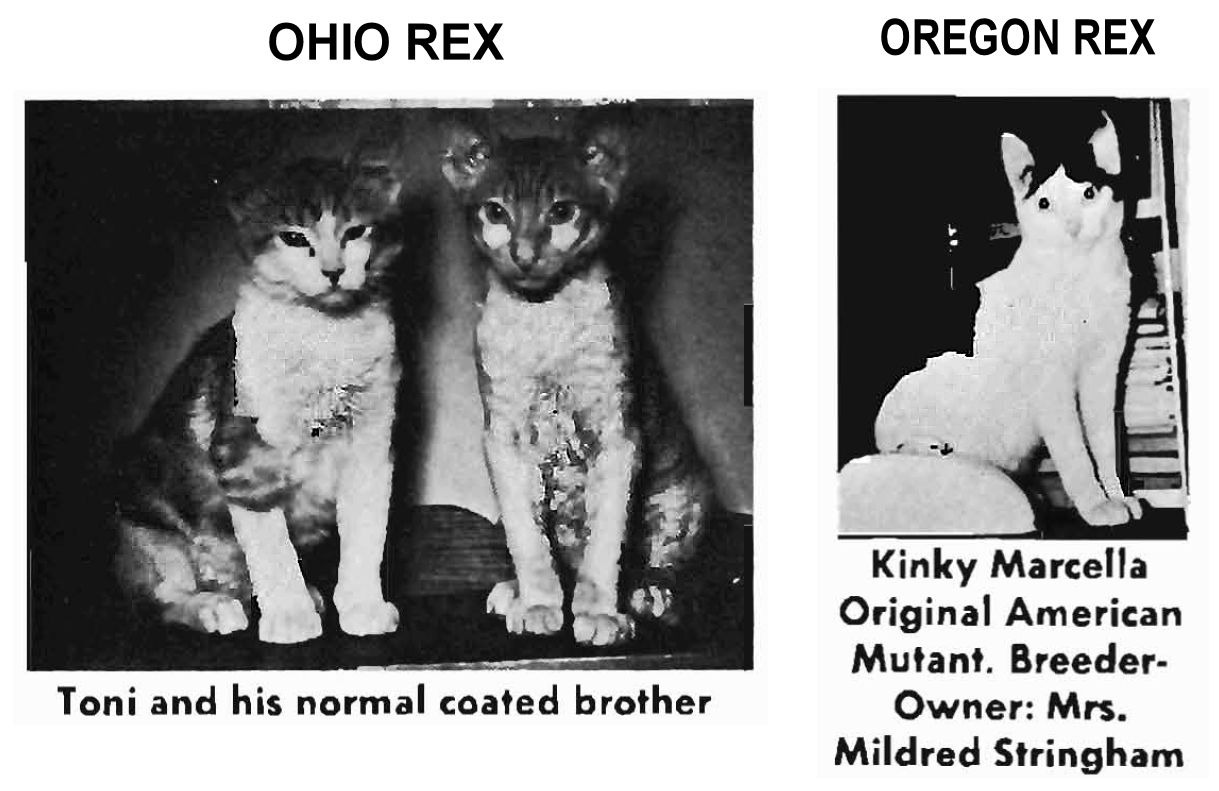
1972. CONNECTICUT REX
In 1972, the Connecticut Rex appeared. On April 21, 1972 Mrs Millie Bourelle s cat Puff delivered a litter of six kittens, one of which had a curly coat. Puff was a mixed breed that had been allowed to roam at will near her home In Windsor Locke, Connecticut. The curly-haired black male kitten was named Schatze (treasure), and Mrs Bourelle sent hair samples of Schatze to Roy Robinson who indicated that the Connecticut mutation was closest to the Oregon type. Puff had another litter on August 17, 1972 which consisted of three Curly kittens and three normal coated ones. Two of the rex kittens died within twenty f our hours. Rex breeders became involved in an effort to help Mrs Bourelle with the Connecticut mutation.
1972. VICTORIA REX
A curly coated cat was discovered in the Victoria area of London, England in 1972, but this Victoria Rex was never established as a breed. A hair sample taken from the Victoria Rex proved to be different from the Devon Rex. Named Tuoh, the Victoria Rex was described by Peter Davis in the 1972 Cats Annual noting that no matings with Cornish Rex had yet been achieved. Other related cats also had curly coats, but nothing more was heard of the breed after that.
Two rexed cats occurred in Lanzarote in the Canary Islands in 1981 and again in 2000. It is possible they were due to recessive genes in a random-bred population (e.g. from an imported rex cat) though the 19 years between them makes this less likely: a recessive gene would have shown up more often. It isn't known if the mutation (or mutations) was compatible with the other rexes in existence at that time.
1981 / 1994. BOHEMIA REX
The Czech Curly Cat or Bohemia Rex was discovered in 1981 in Liberec, The Czech Republic but not recognised until 1994. Persian breeders discovered curly kittens in pedigree Persian litters. The parents of the kittens traced back to two blue Persian males imported from Germany in the 1970s. Either the gene arose from a spontaneous mutation or because Persian cats had been used in a German Rex breeding program and some of their progeny had been registered as Persians. Like the German Rex, the gene is recessive. One test mating of a Cornish Rex and Bohemia Rex produced curly-haired kittens, but another test mating produced straight-haired kittens. This suggests that some, but not all, Bohemia Rexes have the Cornish (German) Rex gene in addition to a new unknown Rex gene and that other Bohemia Rex have the unknown gene on its own. Czech Curly cats are basically Persians with the fur falling in tight ringlets and crimps on the body and looser curls on their backs. At first there was little interest in longhaired Rex cats because the fur was untidy and unruly. Following the success of the Selkirk Rex Longhair, there seems to be renewed interest in the Bohemia Rex.
1982. LAPERM
The LaPerm (formerly the Dalles LaPerm) also comes in Longhaired and Shorthaired varieties. These trace to a group of farm cats in Oregon. A kitten born in 1982 was bald at birth, but developed a coat of curly fur and was named Curly. Curly's offspring inherited this trait and as more and more curly kittens arrived, a serious breeding programme began. . The LaPerm was recognised in 1995; the names Indian Rex and Native American Rex having been rejected. LaPerms are lean semi-foreign cats, originally described as having silky single coats, though they actually do have a minimal undercoat. The longhaired variety has ringlets while the shorthairs have tight curls.
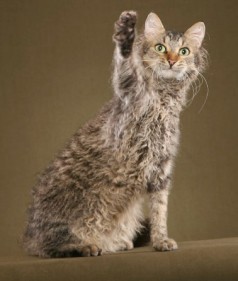 |
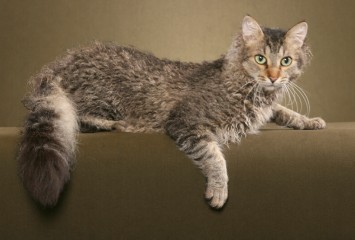 LaPerm photos copyright Helmi Flick. The cat is Quad Grand Champion Alter RedDazzle BC Sweet Tyler, bred by Doreen McCann & Jerrie Wolfe and owned by Shirley Lawler |
Like the Devon and Cornish Rexes, the LaPerm has become a foundation breed in another variety. The Skookum (formerly LaMerm) was developed by crossing LaPerms and Munchkins to produce a Rex-coated Munchkin with either long or short hair. It is described as the Shirley Temple of the cat world.
1985. DUTCH (WIREHAIR) REX
The Dutch Rex (Wirehair Rex) reappeared in 1985 and was described as having a bristly, wavy coat with a brittle texture. It was reported in Dutch cat fancier magazines but little has been heard about this variety in recent times.
1980s. REXED MAINE COON
The Maine Coon Rex or Maine Waves appeared in pedigree litters in a number of breeding lines in the 1980s, causing huge controversy in the very conservative and inflexible British cat fancy and Maine Coon Cat Club. It has fine, frizzy, crinkled fur. Many were immediately neutered by breeders despite the interest shown by others and by the public. Maine Waves is a pet name for those Rexed Maine Coons born from test-matings in a Rex elimination Programme. The Rexed Maine Coons appeared in a number of breeding lines and the few test matings with Devon and Cornish Rexes were inconclusive, but indicated that this was either a recessive or incomplete dominant gene and was not a result of recent outcrossing to established Rex breeds. Several imported cats were implicated as carriers but were no longer available for testing, besides, only British breeders had encountered the trait. There were accusations of undeclared crossing with Cornish Rexes even though test matings suggested different genetics.
Where widely used breeding cats are retrospectively found to carry a recessive anomaly, inter-breeding will already have resulted in a rash of the same anomaly and can expect to see more. Breeders are faced with trying to preserve the breed while eliminating the undesirable recessive gene. By the time the link to the original carrier is established, it may be impossible to eliminate the gene. The British Maine Coon Cat Club declared the Rex gene to be deleterious on the basis of one or two early deaths in Rexed Maine Coons (others remain healthy). In the 1990s, it was decided to neuter male carriers (no test matings allowed) and restrict female carriers. Due to the use of undetected carriers in several breeding lines, the recessive "taint" will persist, hidden, in the breed. It will skip generations, only to resurface by chance years later.
Under UK cat fancy rules, they cannot form a New Breed because they are 100% pedigree Maine Coons and can therefore only ever be recognised as a Maine Coon New Variety. This is a shortcoming of the British system (highly inflexible and also inconsistent). In America, the new variety of Maine Coon would probably have been greeted with some enthusiasm and kept separate from mainstream Maine Coons and given an appropriate name which may or may not have referred to its Maine Coon origins. In Britain the matter was to be swept under the carpet. Even more ludicrously, the club demanded that breeders should declare in writing that the term "Maine Wave" should not be used in any publication in any context. Maine Waves have been shown on the Continent and won certificates. They are very attractive cats and, regardless of cat club politics, bureaucracy and short-sightedness, they deserve recognition in their own right as a breed separate from the Maine Coon. The opportunity to develop this gene may have been lost as a result. It can only be hoped that the mutation will show up again (due to undetected carriers), but will do so in a country with a more progressive attitude to the appearance and handling of new mutations.
The rex gene is either still in the Maine Coon gene pool or the rex mutation has occurred a second time. In 2002, Ellen Levin of Tribeca Maine Coons had two rexed Maine Coons turn up in a single litter. Tribeca is close to the site of the Sept 11 attacks and the breeder and her cats had to evacuate with her cats. This took several days due to safety issues and the overpowering chemical stench and lack of water. A few weeks later, one of her cats gave birth to two rexed kittens. It is believed to be a spontaneous mutation and though attributed to stress, the "few weeks" means the mother cat was already pregnant and the kittens already developing i.e. the mutation was already present in the developing embryos prior to the stressful events.
1987. SELKIRK REX
The Selkirk Rex is a chunky cat with a thick coat. Selkirk Rex Longhair and the Selkirk Rex Shorthair arose from Miss DePesto, a cat discovered in Wyoming, America in 1987. Adopted by a Persian breeder, the original calico Rex cat produced 3 curly-coated kittens in a litter of 6, indicating a dominant gene. Selkirk Rexes were bred with Persians and Exotics to produce a chunky cat with loose wavy curls and a plush, thick coat. It was recognised in 1990 and is now a well-established, popular breed.
Unlike the Cornish and Devon Rex mutations, the Selkirk Rex mutation is an incomplete dominant. The Selkirk Rex standard requires a sturdy body type, wide-set eyes and ears, and moderately short muzzle. This conformation is found in heterozygous Selkirk Rexes. Homozygous Selkirk Rexes tend to have different hair curl, more slender body conformation, larger ears and different head shape than the heterozygotes, leading to comparisons with the Devon Rex head shape. A splice variant in the KRT71 gene is associated with the Selkirk Rex coat type. KRT71 is crucial for keratinization of the hair follicle. An allele of KRT71 is also responsible for Sphynx and Devon Rex. By 2022, three mutations in the KRT71 gene had been identified in cats, forming the allelic series (most dominant to most recessive): KRT71SADRE [Selkirk] > KRT71+ [Wild Type] > KRT71re [Devon] > KRT71hr [Sphynx].
The American Wirehair and LaPerm genes are at different loci to the Cornish/German Rex (LPAR6 mutation) and Devon Rex genes. The Ural Rex has a mutation in the LIPH (lipase H) gene.
1990s. MISSOURI REX
The Missouri Rex appeared in the early 1990s. it is shorthaired cat with smooth wavy fur, a semi-cobby body, large low set ears and "loopy" non-brittle whiskers. Its coat is due to a recessive gene. By the late 1990s there were only three Missouri Rex in existence due to financial mismanagement of the breed which led to most being destroyed. Missouri Rex have been test-bred to Devon and Cornish producing only straight-haired kittens demonstrating that it is a different mutation to either of these. If it still exists, its future is uncertain.
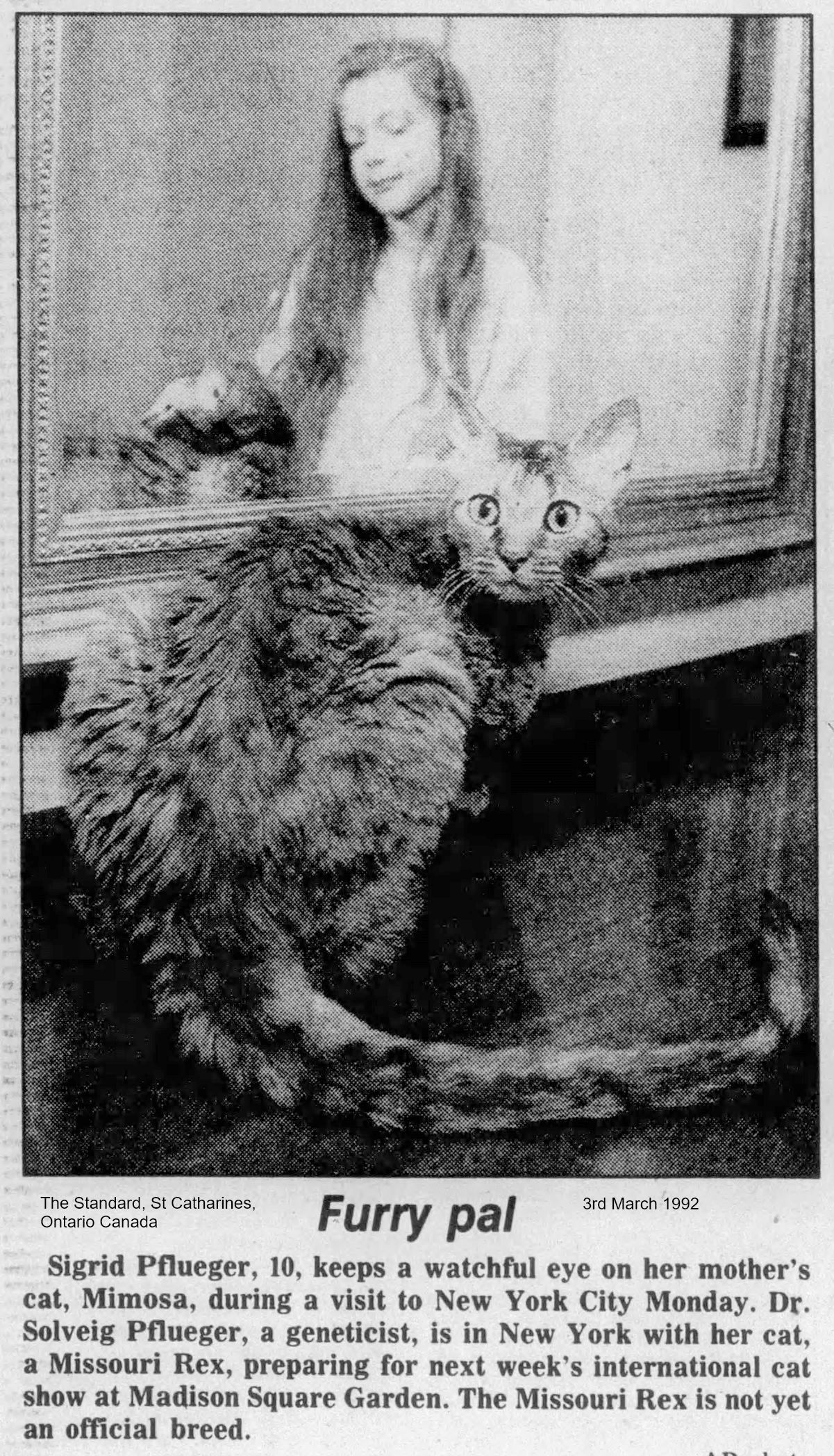
1992. TEXAS REX
The Texas Rex was a single kitten born in 1991/2. There were plans to breed from this kitten, but nothing more was heard.
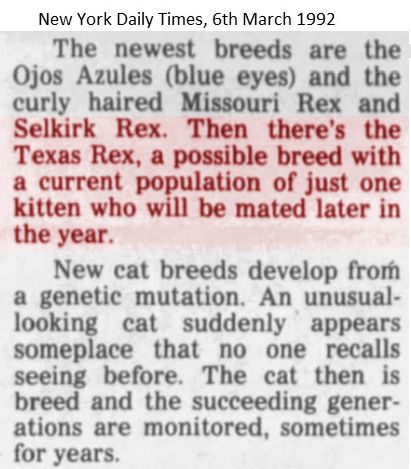
2001. DAKOTA REX
The Dakota Rex also appeared in the late 1990s and there were plans to establish this breed although breed development is very much in its infancy.

2001. IOWA REX
The Iowa Rex mutation was reported in 2001 when a male cat sired curly coated kittens in several litters, including longhaired Rexes. The longhaired version has fur which hangs in "dreadlocks". Iowa Rex have long whiskers and are large, muscular rangy cats. They have a distinct head type with well developed broad muzzles. The discoverer hoped that an experienced breeder would take over these cats as foundation cats for a new breed.
2002 or 2003. PRAIRIE REX
In 2002/2003, several curly-coated cats were found at a farm in Saskatoon, Canada. A colony of curly coated cats had apparently been breeding for up 10 years. Being farm cats, they were healthy and vigourous. Martine Sansoucy of Butterpaws Cattery (breeders of LaPerms) found the rex colony of cats on a farm just outside of Saskatoon. She took 7 marcel cats (cats with wavy kinked coats and curly whiskers) and one extremely curly coated female. The marcel cats were all neutered and homed as pets, while the curly coated female was kept for test mating. A test breeding of the female with a straight coated (to determine whether the gene was dominant or recessive) produced 7 kittens including one solid blue bald female. The gene was proven dominant, but the kittens were all extremely small and unhealthy and all but 2 died. The blad female was one that did not survive. The surviving kittens were both straight coated; they were neutered and homed as pets. The curly coated mother went bald during her pregnancy and her coat grew in straight coated afterwards which was odd. After many Vet visits it was confirmed that she had elbow dysplasia in her left elbow and Butterpaws decided not to pursue the new gene due to the mother's genetic health problems. She was spayed and homed as a pet and remains straight coated, but with extremely curly whiskers. Martine Sansoucy visits the same farm yearly, but no further rexes have appeared there. The main producer of the rexes appeared to have been a chocolate point marcel male. Although the line appears to have died out, this rex variety has been named the Prairie Rex because the cats were found in the prairies.
Martine is waiting to see if any coat changes happen with Bobby in the next few years as she is only about three years old and was 8 months old when bred. The necessity to spay Bobby due to health problems makes it regrettable that the less curly marcel males were neutered. Intriguingly, the problems of balding and of curly hair being replaced by straight were encountered in the Dutch Rexes, another dominant gene mutation, during the 1960s.
|
|
Left: Bobby in full curly coat |
2003. BROOKLYN WOOLEY
In 2003, some "Wirehair Rexes" were born in Brooklyn, USA, but unfortunately died. The mating was repeated, additional heating was provided for the kittens, and the breed is now under development by Sarah Sweet. The sire, Wooley, was a cat with wiry rex coat, curly guard hairs and hardly any undercoat. Wooley's mother (the foundation cat) had 2 bald kittens with curly whiskers, born before Wooley, that did not survive. The effect of the Brooklyn Rex mutation is a rippled coat with all hair types and bald kittens which grew coats. By 2006, there were a total of 9 Wooleys. They are low-shedding on a day-to-day basis, but periodically moult the hair on the belly and inside the legs, creating bald spots that an unwary observer might mistake for a skin disease. The hair regrows as wavy as before. In general, Brooklyn Wooley kittens are born bald, or almost bald, and grow (or regrow) curly fur, but have minimal fur on their bellies. Early on, a variety of fur types and fur growth patterns were noted: some were born bald on the belly and had normal-haired siblings; straight-haired cats with coarse coats developed wavy fur. Outcrosses have not produced any Wooleys, but even in matings between a wooley and a related cat there might be no Wooleys or a mix of curly-haired and straight-haired kittens! The hair type can also change: kittens with straight, coarse hair later turn wooley while born-curly wooleys turn straight and then curl up again periodically for a few months and then remain curly, but they may have a bald belly until about 9 weeks. Kittens tend to open their eyes early. Wooleys are very outgoing and affectionate cats and really love to greet people and cuddle. Blue-eyed colourpoint Wooleys also occur. Initially the Ojos Azules gene was suspected due to the flattened tail-tip and wide-spaced eyes, but this has been discounted. The Brooklyn Rex mutation is being developed under the breed name of Wooley (originally Brooklyn Wooley) and initially thought to be identical to the Texas Rex mutation or to the short-haired LaPerm. Breeding over the next few years established it to be a new recessive gene.
|
|
|
|
Scrappy Wooley (Photos copyright Sandy Sweet. )
| |
2003. TASMAN MANX (REX-COATED MANX) In December 2003 a Manx Rex/Curly Coated Manx strain, now called the Tasman Manx, was reported in Australia and New Zealand. Some Manx breeders found curly coated kittens in their breeding lines. They liked the look of the cats and rather than take the Maine Waves approach and vilify them, decided to research the variety. The gene is recessive and produces a frizzled, relatively thick coat with guard hairs. When test-mated to Devon Rexes, only straight-haired kittens were produced. It also appears different to the Cornish Rex gene as the cats have visible guard hairs while Cornish Rexes lack. The Tasman Manx cats can all be traced to an outcross mating in Australia using a cream Persian male with some European ancestry. This led to the suggestion that the gene is the same as that which causes the Bohemia Rex (discussed earlier). Debbie Munro provides the following description, history and photos of the Tasman Manx. She hopes to have the variety recognised by the NZCF and to conduct test matings with Cornish Rex. Debbie had the first Tasman Manx born in New Zealand. Tailed curly-coated Manx kittens turned up with Debbie and also with two other breeders, one in Australia and one in New Zealand. However the Australian kittens were stillborn and a test mating resulted in further stillborn kittens so it was not pursued due to fears of a lethal mutation. The two tailed curly-coated Manx kittens born in New Zealand were not bred, leaving only Debbie's cats cats. Debbie's first tailed curly-coated Manx were born around 1998 and went to another Manx breeder for breeding. Unfortunately, that breeder's stock was later dispersed and the whereabouts of those two curly-coated Manx males is unknown. A Brown Classic tabby Bi-Colour Manx, "Arther", was born to Bywater Barabbas (one of the founders of the "CC" [Curly Coat] gene) and was the first tailless CC Manx in Australasia. A year later, "Curly Sue", a half-sister to Arther, was born. She was mated to straight-coated Manx who were suspected of carrying the CC gene as well as to her half-brother. "Brandy", a straight-coated half-sister of Arther was mated to Arther, resulting in "Kiwi", a cream curly-coated Manx male. Curly Sue has since produced a much needed Blue-Cream curly-coated Manx female. Debbie's photos show Peewee, a Blue curly-coated Manx and the Blue-Cream curly-coated Manx female. The kittens are born well furred, but this starts dropping at around 3 weeks, starting with belly and working upwards. The fur under the neck form nice rings of curls. Debbie has also provided a photo of one of the "Egerton" Curly Coat Persians from Australia, where the CC gene is known to have come from. In contrast to the GCCF's approach, the Australian/New Zealand cat fancies seem more open to accepting, investigating and pursuing spontaneous mutations or carried recessives in existing breeds.
|
|
|
|
|
CC Manx (Tasman Manx) and CC Persian photos courtesy of Debbie Munro, The Manx Cattery, New Zealand |
|
2004. HOOSIER REX
In 2004, an abandoned curly-haired female and her 4 curly kittens were found in Indianapolis, USA. Dubbed the Hoosier Rex, the female had short, loose curls while all 4 kittens had curly fur ranging from tight curls to loose waves and were curly-furred from birth. This could have been a new dominant mutation although it was possible that the female was from LaPerm stock. All 5 cats were relinquished to a shelter where there was a legally binding neutering rule, so it was not possible to research the gene further. Further information has been provided by Ashley Lewin. The mother cat was a dilute calico with Foreign features: an angular face, large ears and blue eyes. Her coat had short swirly curls that felt like velvet. Three of the kittens had the same conformation, though the fourth was an orange tabby male with a rounder face and smaller ears. The orange tabby male had long, soft, wavy fur. The other male resembled the mother and was white with light orange markings on the head; his coat was short, kinky and felt like cotton. The first female kitten was a Foreign-looking tortie-and-white with a short, kinky coat. The remaining female kitten, named Saganaki, resembled the mother with a Foreign face, large ears, long, curved whiskers and green eyes (cross-eyed).
|
|
|
|
|
Hoosier Rex "Saganaki". Photos courtesy Ashley Lewin |
||
Saganaki is tabby-tortie with silvery blue in place of black with the short, swirly curled velvet-like coat of the mother. Saganaki had an approx 2 inch mohawk (mohican) ridge that started at the back of her head, paused on her shoulder blades and then extended down her back and tail. The ridge grew in when she reached 4 months old, but has mainly gone as the other fur grew and caught up with the mohawk. The hair on her head and face remained quite short and that on her shoulder blades is also shorter, resulting in a ruff on the back of her head and upper back. She resembles a LaPerm, but with a more oriental face. She is vocal with a comical, affectionate personality. Her coat is somewhat greasy and can be easily plucked, like a rabbit s coat, and has the habit of picking things up.
In the previous two and a half years, the Humane Society of Indianapolis had received two other curly coated adult stray cats. One was a large adult black and white unneutered male with long, tight ringlets all over his body. There is no description available of the other except that it had curly fur. Ashley says there are stories of curly or kinky coated cats and kittens of unknown parentage turning up in shelters across the state.
|
Possible Hoosier Rex "Ugly Betty". Photo by Trish Madigan |
Trish Madigan, a rescue worker in Columbus, Indiana, USA cared for a pregnant feral female that had 2 curly-haired kittens, only one of which survived. Four other surviving kittens were straight-haired. The father's coat type is unknown. "Ugly Betty" was born with a bald belly and legs and has kinked whiskers. No feral rex cats (of known breeds) have been reported in Southern Indiana. LaPerm was originally suspected due to the baldness at birth, but this may be another Hoosier Rex type cat as these turn up across the state according to Ashley Lewin (Saganaki's owner)
2004. TENNESSEE REX
In August 2004, cat lover Franklin Whittenburg in the Tennessee Valley in the Chattanooga area took in a feral female and her 3 kittens, of which 2 had curly fur. They had taken refuge on his back porch and a previous feral litter had been killed by a large tomcat. At the vet clinic, where they were treated for parasites, everybody wanted to see the 2 rex-coated kittens. The mother had straight fur and the mutation appears to be recessive and probably manifested due to inbreeding. The kittens were curly from birth and had very short, extremely curly whiskers and eyebrow whiskers. Curiously, the 2 curly-coated kittens moulted heavily on their temples and were temporarily bald in those areas. DNA testing of Tennessee Rexes (T-Rexes for short) eventually found them to have a different mutation to other rexes. Breed development began with kittens from two totally unrelated females that were mated to different Tennessee Rex brothers. Although the offspring would be straight-haired gene carriers, the recessive gene would show up by mating the offspring together. The next test mating was with the daughter of one Tennessee Rex to her uncle.
Tennessee Rex kittens have small tight curls which become "corkscrews" when and where the hair grows longer. The curly hair is most prominent on the neck, shoulders, chest, stomach, legs and tail. It forms longer wavy curls on the back. Even the whiskers are curly. The tail is one of the most striking features of the breed. The long "corkscrew" hair makes the tail expand the width of the cat when it is carried in the upright position.
|
|
|
|
|
Tennessee Rex and Radical Satin hair-shaft photos courtesy F Whittenburg |
||
A spontaneous new rex mutation is rare enough and very desirable, but the Tennessee Rex held an additional surprise. It has an extremely rare "satin" or "glitter" mutation. Currently the only breed exhibiting the "glitter" gene is the Bengal where it resembles gold dust sprinkled on the fur. Test mating between a Bengal and a Tennessee Rex has shown these are different mutations. An outcross of Tennessee Rex female to a domestic shorthair male also produced shiny-coated but not Satin-coated straight-haired offspring. Carriers of the gene appear to exhibit a degree of shine while the "radical satin" effect has appears restricted to the rex-coated individuals. The satin mutation may be linked to the rex mutation in the same way that Bengal glitter appears linked to the Bengal patterns. This is similar to the expression of Satin in mice where homozygous mice (2 copies of the recessive gene) are satin-coated, and heterozygous mice (1 copy of the gene) may show a lesser degree of satin. However, if all heterozygotes have a degree of satin then this is also the behaviour of a dominant gene with an additive effect - mild satin in heterozygotes and "radical satin" in homzygotes.
A different gene, called "satin", is seen in rodents but has never been confirmed in cats. Dr Solveig Pflueger (Tufts University School of Medicine, Boston) and Dr Leslie Lyons (University of California, Davis) studied hair samples to see which mutation it is. The satin sheen stands out when compared to a normal haired cat. When the fur is viewed closely in direct sunlight, there are tiny little prisms in the fur that refract the light to produce the colours of the rainbow. At first, these were thought to be "air pockets" in the hair shaft that that refracted light rather than simply reflecting it. Close examination of the satin on the original Tennessee Rex males showed a reflective coating similar to oyster shell on the hair shaft along with triangular ridges. Straight haired offspring showed some air-pockets. Normal cat hair has a relatively solid core of pigment. Satin Tennessee Rex hair has looser, irregular bands of pigment while glittered Bengal hair has more tightly packed pigment granules forming a narrower core. Hairs from crosses of satin Tennessee Rex x glittered Bengal more closely resemble those of the Bengal than the Tennessee Rex. If this rainbow effect mutation were to occur in a white Tennessee Rex it would produce "oyster shell" or "pearl" colour that would be unique to the breed (previously the only breed to have a colour like this was the now extinct Suqutranese; a white semi-longhair with translucent bands on the hairs). Satin is part of the Tennessee Rex breed standard. In combination with the curly fur, the effect is unique. In addition to their fur type, the T-Rexes are non-aggressive, playful and puppy-like in their affectionate behaviour. They are very human-oriented.
At one point the breed was reduced to critically low numbers, but the uniqueness of the satin coat has been recognised and numbers are increasing using suitable outcrosses. Two satin-coated rexed cats appeared sontaneously in Mackay, Queensland, Australia in 2016 and one, a torbie female, was exported to Canada where she was mated to a carrier of the Tennessee Rex gene. The two kittens both had the rexed satin fur, proving they had the same mutation. They have been used to expand the Tennessee Rex gene pool.
2005. AUSTRALIAN REX
|
|
In 2005, a Rex-coated line of cats was reported in Australia. The line began in 1998, when a pet cat had kittens, including a curly tortoishell with fur not dissimilar to a Cornish Rex. However, there were no Cornish Rexes in the area (although the gene may have been carried by a cat with Cornish Rex in its ancestry) or it may have been a spontaneous mutation. The curly kitten, Roxy, matured, but remained one third smaller than the average cat. Roxy has produced several litters, each including 1 or 2 kittens with curly fur and sometimes having kittens that mature into smaller sized cats. One of her sons, Timmy a black-and-white tuxedo pattern cat, is about half the size of a regular cat at 18 months old and has a tail longer than his own body. His younger brother, Tommy, also has curly fur and some Oriental facial features. Timmy has been neutered, Roxy became too ill to breed and the curly-coated daughters have disappeared, leaving only Tommy able to father more litters. Unfortunately, cats and cat-breeding are not widely liked in Australia which may result in Tommy also being neutered (this is compulsory in some areas) and the anomaly dying out.
2009. HELKI
The Helki (2009) developed from feral cats by Aubrey Anderson has a "semi-rex" coat that has a mix of wavy and straight guard hairs that can look unkempt. Helki, means "touch" in Miwok Indian (Northern California) and reflects the silky, fleecy texture of the coat. Early breedings to domestic cats show 50% semi-rexed kittens indicating a dominant gene mutation. Non-rexed kittens can display a mohawk (upright ridge of fur) along the spine when happy. As well as the texture, the fur has a high degree of rufousing, making some colours hard to distinguish. The colour can change during the cat's life; a cream kitten may turn blue and end up reddish-brown while a blue may turn black. The wavy, brittle whiskers are moulted in the first year and replaced by long drooping whiskers and there is a Laperm-like moult of wavy fur as the kittens grow. The breed was mainly developed from feral/semi-feral cats around South Sacramento (Northern California) and the mutation appears to have originated there with LaPerm-type cats also present among local feral colonies, however the Helki is smaller than the LaPerm. The local feline population includes descendents of various Asian cats that arrived with immigrants several decades previously. Breeding ceased in 2012 due to a combination of changed personal circumstances and lack of interest from other breeders, in part due to the appearance of, and interest in, the sparse-haired Lykoi.
2014. FLEECY CLOUD (RUSSIA)
Firstly, this mutation occurred naturally in Russian breeding lines and not from a deliberate attempt to create rex-coated Scottish Folds. Several known rex mutations have been ruled out so this may be a spontaneous mutation. The fur of the Russian-bred Fleecy Cloud breed is distinguished by its large, elastic curls that are soft to the touch. The coat looks impressive and the curls never droop, but look more like fleecy clouds, hence the name. The ancestors of this breed were purebred Scottish cats who produced some curly-coated cats. Today breeders are committed to fixing this gene and improving the breed.
In January 2014, a strange curly-haired kitten was born in the litter of pure-bred Scottish cats Daryl White and her son, Nestor Petrovich, owned by breeder Margarita Egorova. The curly kitten was named Snejana. Margarita Egorova was interested to see how the kitten would develop and kept it for study. When Snejana grew up, her fur formed large waves. Margarita also wanted to know if this was a one-off or whether the same mating would produce more curly kittens. In their next mating, Nestor and Daryl produced two curly-coated white kittens, named Kelvin and Kudriashka Sue, a white male Scottish Fold (went to a pet home) and a lilac female Scottish Straight. The lilac female was assumed to be a carrier of the curly gene and was mated to an unrelated bicolor Scottish cat who was also was a gene carrier. This paring produced 4 kittens, one of which was curly.
The mating was inbred, so it was assumed that a recessive rex mutation was being expressed. This was confirmed by the fact that both cats had produced litters with other partners without producing rex-coated kittens. However, curly-haired kittens were also born in a litter of the same cat, Nestor Petrovich, and cats of unknown origin that were phenotypically Scottish fold. Curly-coated kittens had also been born repeatedly in Scottish Fold litters (in Russia), but no-one was working to identify the rex gene involved. The recessive Urals Rex gene was ruled out because that native Russian breed has not being crossed with other cats.
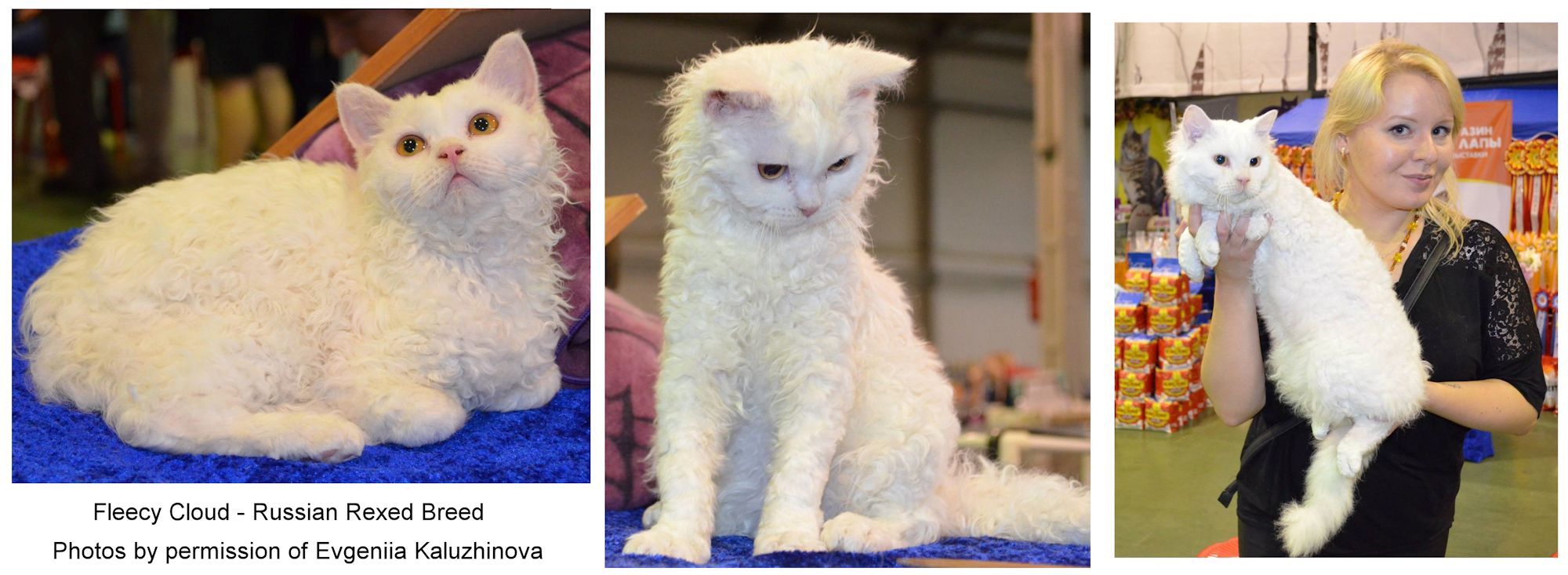
Because curly kittens were born to straight-haired parents on both occasions, it was clear that this was a recessive gene. The breeder had two assumptions about the genetic basis of these kittens curly hair. The first was that it came from the Bohemia Rex (aka Czech Curly Cat), a rex-coated Persian-type cat bred in the mid-1980s in Czechoslovakia. This breed had the Cornish Rex gene, and though the breed was lost, the Cornish Rex gene persisted in the Persian gene pool and found its way into the gene pools of British Shorthairs and Scottish Folds when Persian blood was used to improve conformation. Being recessive, it was periodically expressed when carriers were mated together. At the start of the 21st century, curly-coated Persians quite often appeared in Belarus, Poland, and Moscow, but breeders had no interest in them, and the trait became rare in the Persian breed. On the other hand, it was not so unusual for rex-coated Scottish Folds to appear in Russia. Because Persians were used to give the Scottish Folds more rounded heads and a shorter-nosed, sweeter expression, and create a longhaired version, it was assumed that the Cornish Rex gene had been introduced at this time. However, DNA testing has ruled out the Cornish Rex gene.
The second theory was that the rexed Scottish Folds were due to the Devon Rex gene via the Poodlecat (Pudelkatze). In the 1980s, German breeder Rosemary Wolf developed a new and unusual cat by crossing a number of breeds together. Early on she used the Somali, Maine Coon, Norwegian Forest Cat and Chartreux. Later crossed the Devon Rex and Scottish Fold creating the first Poodlecats, with folded ears and rexed coats, in 1994. Long years of breeding and careful selection led to partial recognition of the experimental breed by FIFe, but lack of recognition by other major registries meant the breed stayed rare and is now presumed extinct. The possibility of the Devon Rex gene entering the Scottish Fold gene pool could not be ruled out without testing. DNA testing of Fleecy Cloud cats ruled out the Devon Rex gene.
DNA from the rex-coated kittens was tested at the Veterinary Genetics Laboratory School of Veterinary Medicine, Davis, California, ruling out the Cornish and Devon rex genes. Selkirk Rex and LaPerm were ruled out because they are dominant mutations. The Russian cats were therefore a unique mutation. The Fleecy Cloud breed is therefore considered unique by expert felinologist, and president of the "FELIS" cat club Nina Vladimirovna Ekimova, who conducted a review of the cats. Together with Nina Ekimova, Margarita decided to develop the cats as a new breed called FLEECY CLOUD. The name reflects the fur type. Nina visited many exhibitions throughout the country and knew that curly kittens were sometimes born in Scottish Fold litters; she had seen such kittens at exhibitions. The occurrence of rex-coated Scottish Folds was also mentioned in specialist felinological literature. A similar mutation had appeared in St. Petersburg (Russia) and also in Kazakhstan, where breeders tried to develop a curly-coated Fold.
Fleecy Clouds look very different from Scottish Folds. The kittens muzzles are not so round, and they have broad cheekbones and have almond-shaped eyes set obliquely. These features become more pronounced with age. Breeders are working to preserve and enhance the difference between the Fleecy Cloud and the other recognised rex-furred breeds.
The fur forms large open curls and lies in dense waves. Both awn and down hairs are present and have the same curliness. The texture is springy and not too soft and when stroked the curl can be distinctly felt as well as seen. The fur is shiny and slick-textured, but is not oily, and does not become tangled or droopy. The curls do not straighten with age and curls that are disorderly in kittens become regular as they mature, forming neat rows in adulthood with no sparse or bald areas. Kittens are born with very twisted whiskers which straighten into waves as they mature.
Fleecy Cloud cats have very friendly and non-aggressive temperaments and love to communicate with people. This, along with their unique features, makes them a valuable addition to the showbench and the pet home.
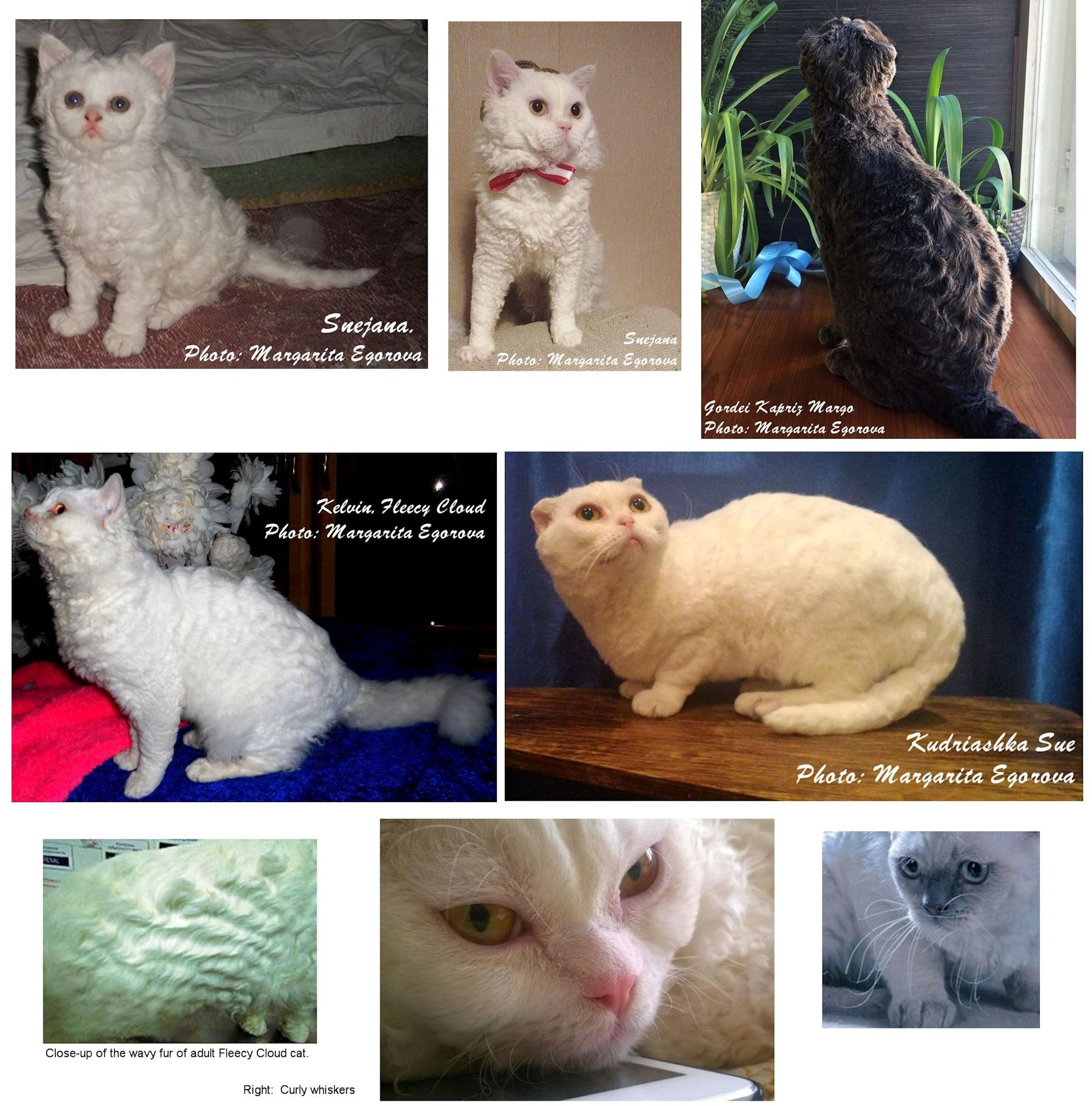
Independently of Margarita s breeding work, in the Perm region of Russia, Lana Nasurdinova began to develop curly coated cats from a cat bought in St. Petersburg. When the two breeders met, they realised that they had the same goal and decided to work together. Margarita s breeding programme was further advanced and had a larger genetic pool so the breed development programme was based on this. Margarita gave Lana the right to use the registered name and breed standard and the two breeders exchanged cats with Aleecy joining Margarita s cattery.
To expand the gene pool, improve the cats type and ensure the breed was healthy, Fleecy Clouds were outcrossed to the Siberian and Neva Masquerade (the colourpoint form of the Siberian). This produced 3 lovely females, one of whom gave birth to an F3 litter containing some new colours. At present, because the cats are few in number, fold-eared curly-coated cats are still used in the breeding programme. In future this will be prohibited. The breed standard calls for straight ears and permits any colour coat and eyes. Both longhaired and short-haired varieties are allowed.
The cats were introduced in the class of unrecognized breeds at the WCF and FARUS show where judges and other experts showed great interest, giving their advice on working with a new breed and wishing the breeders every success.
2017. REXED RAGDOLL
At the end of 2017, Becc Tedder, a Ragdoll breeder in Australia had a curly-coated kitten in a litter of six. Glamason of the Ghetto was born curly and was still curly at nine weeks old. While many kittens born with wavy coats (due to the effect of amniotic fluid) develop straight coats as they grow, this kitten s coat was forming tighter curls and felt like lamb s wool. This was the first litter for his mother, but his father had sired previous litters, none of which had rex-coated kittens.
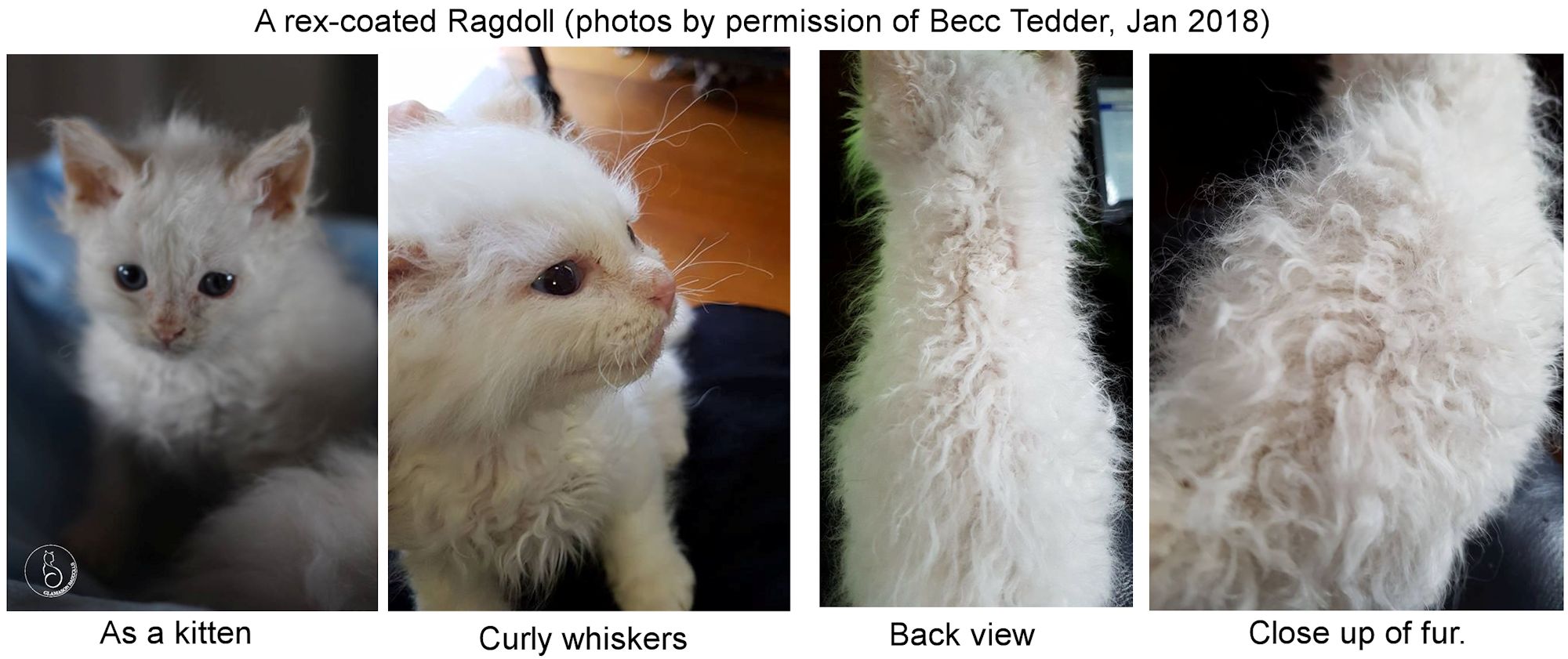
Hopefully a DNA test will rule in or rule out known rex genes. Barring a spontaneous mutation, where could a rex gene have come from? Ultimately, behind the Ragdoll breed are cats of unknown ancestry and unknown genetic make-up as well as outcrosses. All red series Ragdolls result from outcrossing, usually to Persians. Both parents have known Persian ancestry. Superjoy Ice Crystal, a Persian, is in both parents lines. On the SVERAK database, Superjoy Ice Crystal is registered as a Ragdoll, but with no ancestry recorded. Joyce Francis (Superjoy prefix) bred Persians. The mother of stud cat Lonerock Ice Cream of Starliterags known as the "Ice Cream Cat," who was behind the red lines, was a Persian called Oh So Mellow of Lonerock. Sheyenne Nighttime Nick of Coed has an unregistered mother. Some Persian lines carry the Cornish Rex gene, which has previously appeared in the naturally occurring Bohemia Rexes in the 1980s. Recessive rex genes can be passed down the generations unseen until two carriers come together and produce rex-coated kittens.
There are also cats in the pedigree from a cattery which also had Sphynx, and Sphynx have been crossed with Devon Rex. There is also Balinese several times in both parents pedigrees (Balmisten Barkarcri, Dejanda Blue Julep) and much inbreeding of these on the sire s side, but this seems an unlikely source of a rex gene.
MISCELLANEOUS REXES AND DERIVATVES
The Bohemia Rex (a Rexed Persian) first appeared in 1981, but not established at that time. In the 1980s some Rex-coated Persians appeared in Britain, but the breeder who had bred the kittens decided not to continue the variety. Whether they were related to the Bohemia Rex isn't known. A rexed version of the Himalayan (Colourpoint Persian) has also occurred; either as a spontaneous mutation or due to carried from a historical outcrossing to cats carrying Rex genes.
The Poodle Cat (Pudelkatze) was developed by Rosemarie Wolff,a German Scottish Fold breeder, in 1987 (a date of 1994 is also given) in Starnberg, Germany from crossings between Devon Rexes and Scottish Folds. It is a large, healthy cat with folded ears and a curly coat resembling lambswool. It is chunkier than the Devon Rex and has a denser coat. Recent German rulings prohibiting the breeding of cats with defects (the Scottish Fold may suffer skeletal defects) may curtail the breeding program in Germany, but there is interest in Poodle Cats elsewhere in Europe. The next stage of development is to use Manx cats to introduce the tailless trait. Some interested breeders have proposed crossing the Poodle Cat with the short-legged Munchkin to produce a breed to be known as the Poodlekin, but this is currently theoretical only.
In 2002, a Dutch source mentioned the Scottish Rex, which might refer to a Rexed Scottish Fold or Pudelkatze.
The Ruffle appeared in the early 2000s among pedigree American Curls. Investigation showed it to be derived from the Cornish Rex. According to one source, in an attempt to improve the ear size of American Curls, one breeding line introduced the Cornish Rex. This had the side-effect of introducing the recessive gene for curled fur. The gene lay hidden, resurfacing as curly coated American Curl kittens some generations later. The rippled effect of the fur reminded the breeder of a type of potato snack hence the name Ruffle. Unfortunately the breeder's circumstances changed and further development of a ruffle breed could not be funded. According to a different source, it resulted from a deliberate attempt to create a new breed combining the curled ears with a curled coat. Regardless of its origins, it is a Rexed version of American Curl (longhair and shorthair) apparently having the Rex gene from the American Cornish Rex. It has curled ears and a curled coat. Face is a modified wedge curled ear and a curled coat. Hind-legs are longer than forelegs. The description suggests a curl-eared Cornish Rex rather than an American Curl with curly fur.
In 2007, Vasilis Lekkas from Athens (who is deeply involved in the recently formed Greek network for the preservation of domestic livestock including cats) reported two instances of Rex type coats; one in the island of Skopelos and the other in suburban Athens.
In 2008, the Kernow was suggested as a truly Cornish cat combining two mutations indigenous to Cornwall. Tailless cats occurred in Pendarvis, Cornwall in 1837 and the variety was known as the Cornwall Cat until 1909 when tailless cats all became known as the Manx. The Cornish Rex occurred in Bodmin, Cornwall in 1950. The Kernow would combine both of these "Cornish" traits and would essentially be a tailless British-style Cornish Rex in both shorthair and longhair versions. The Oriental conformation of the American Cornish Rex and the Siamese/Burmese colours or patterns are not allowed. Blue-eyed or odd-eyed whites/bicolours are not allowed because of deafness. Kernow is the Cornish word for Cornwall.
Finally there is a mistaken identity "Rex". The Colorado Rex appeared on a survey of Rex cats. There is no record of this feline mutation.
REX FUR
In brief, a cat has three main types of fur: long guard hairs, shorter awn (bristle) hairs and woolly down hairs. The guard and awn hairs form the top-coat and the down hairs form the undercoat. In addition, specialised hairs form the whiskers. In general, in Cornish, German and Oregon Rexes, the guard hairs appear to be absent or, if present, are reduced to the appearance of awn hairs. Meanwhile, in the Devon and Selkirk Rexes, all three types of hair are present, but in modified form. Their hair also tends to be brittle and this is most noticeable in the missing or broken whiskers. Wirehair cats also have all three types of hair, but all are rough, crooked and unruly. As more and more rexoid cats are reported, a wider variety of fur modifications are being described. One of the more unusual modifications was a cat reported in 2003 that had long whiskery guard hairs, but lacked down and awn hairs, and was otherwise bald.
DNA analysis in 2010 also found that Sphynx and Devon Rex are different mutations of the same gene. The relationship between these mutations from most dominant to most recessive is: Normal Hair >> Sphynx >> Devon Rex
|
Paul McSorley's Minskin Pixie Puss showing the "fur-pointed" trait. The extremities are furred, while the cat's body is hairless. Photo reproduced by permission of Paul McSorley |
FUTURE REX CATS?
Potentially, any of the Rex breeds could be crossed with any other breed of cat to produce Rexes with bobtails, no tails, extra toes, different ear shapes, Abyssinian Rexes, Hemingway Rexes, Rex-Bobs or any other combination of physical traits. Whether these are desirable is another matter entirely and many experimental cross-breedings are not pursued as breeds.
Meanwhile, curly-coated cats continue to appear in unexpected places - some as a result of mis-matings many generations ago and others as entirely new mutations. Some are the result of existing Rex mutations combining with other genes which modify their effect on the fur. Some of these curly coated cats will be picked up by breeders while others go unnoticed. A few prove to have mutations identical to established Rex breeds. Only time will tell which of these goes on to achieve the same sort of popularity as the pioneering Cornish and Devon Rex breeds. Modern genetic methods may allow "new" rex mutations to be matched to/differentiated from existing mutations, avoiding the necessity of test-mating.
In 2006, TICA proposed to clamp down on certain breeding trends, possibly preventing new rexed breeds that might be created by crossing existing breeds together. Their Genetics Committee report stated: "The Committee proposes that TICA does not accept any proposed breeds for Registration Only status that do not exhibit novel mutations. The current mutations would be reserved for currently recognized breeds exclusively. This would end the seemingly endless applications for "munchkinized" new breeds, and then deter the inevitable introduction of "rexed", "Bob-tailed" and Poly-ed" everything else."
REX OCCURRENCES IN CHRONOLOGICAL ORDER
Si-Rexes are not included as these are simply colourpointed forms of Cornish and Devon Rexes, not separate breeds. With many of the later rexes, the origin of the rex gene could have come from uncontrolled breeding of existing rexes kept as pets.
